Stakeholder Management in Events
VerifiedAdded on 2020/06/06
|22
|5164
|60
AI Summary
This assignment delves into the concept of stakeholder management in event planning. It utilizes the Notting Hill Carnival as a real-world example to analyze various stakeholders involved, their interests, and the strategies employed for effective management. The analysis includes identifying key stakeholders, understanding their power and interest levels, and outlining communication and engagement approaches.
Contribute Materials
Your contribution can guide someone’s learning journey. Share your
documents today.
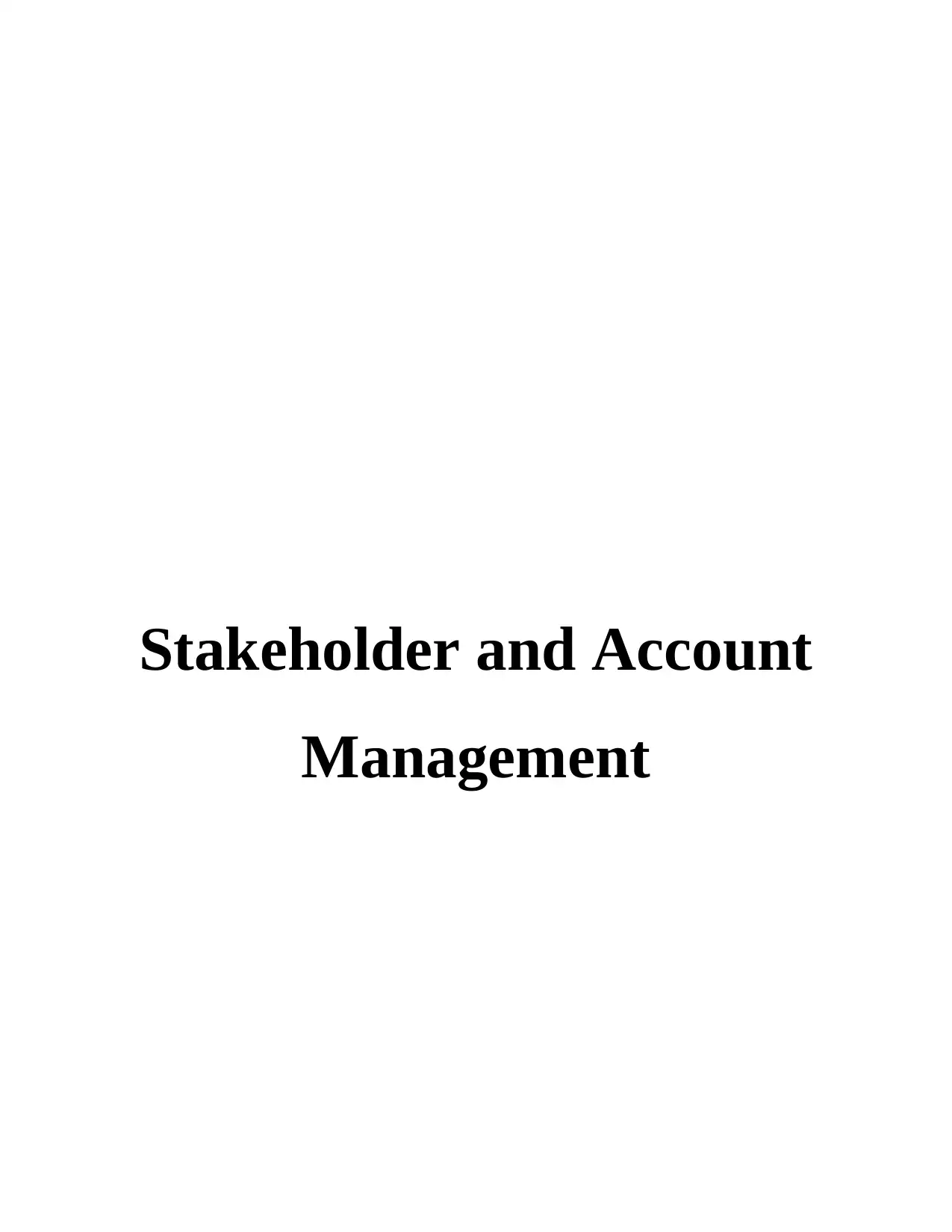
Stakeholder and Account
Management
Management
Secure Best Marks with AI Grader
Need help grading? Try our AI Grader for instant feedback on your assignments.
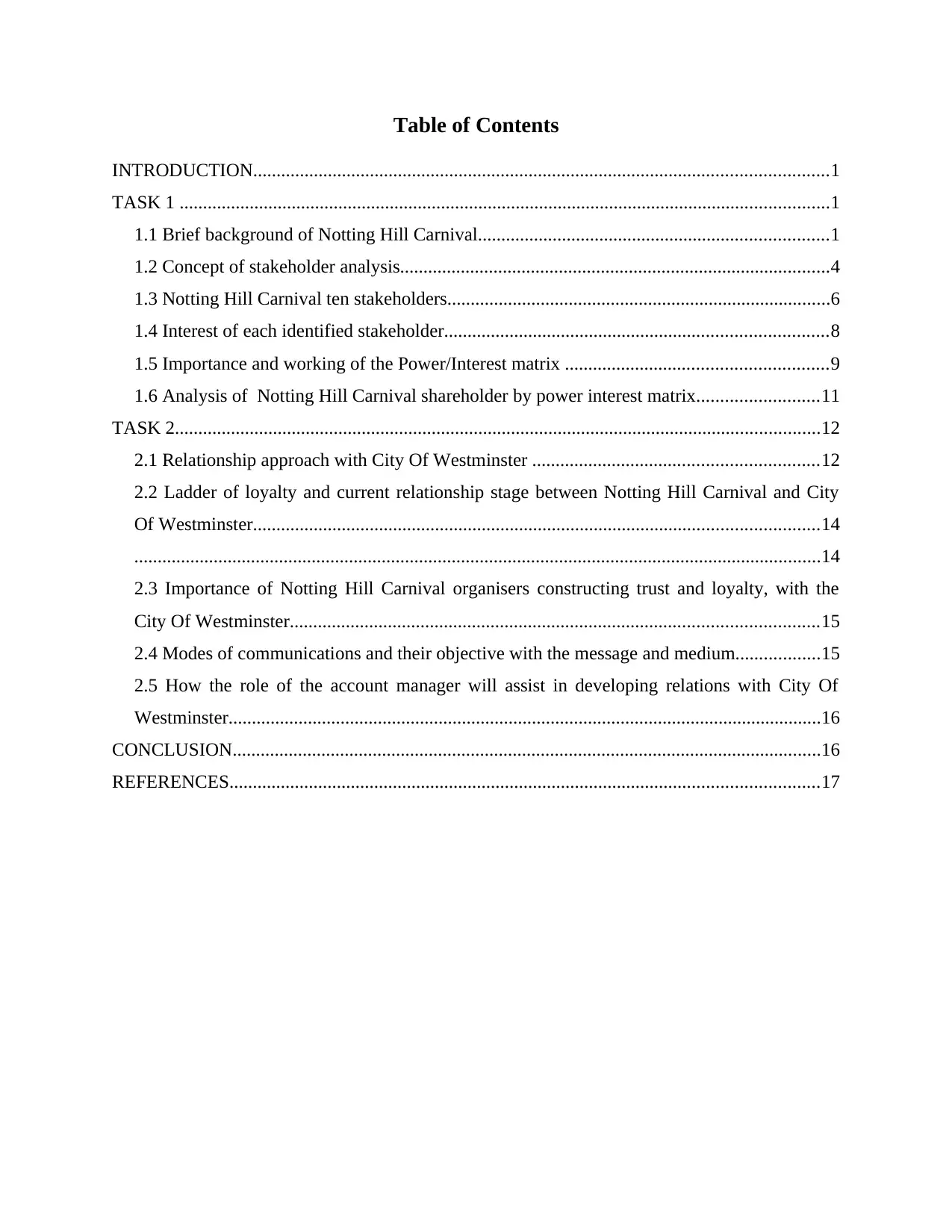
Table of Contents
INTRODUCTION...........................................................................................................................1
TASK 1 ...........................................................................................................................................1
1.1 Brief background of Notting Hill Carnival...........................................................................1
1.2 Concept of stakeholder analysis............................................................................................4
1.3 Notting Hill Carnival ten stakeholders..................................................................................6
1.4 Interest of each identified stakeholder..................................................................................8
1.5 Importance and working of the Power/Interest matrix ........................................................9
1.6 Analysis of Notting Hill Carnival shareholder by power interest matrix..........................11
TASK 2..........................................................................................................................................12
2.1 Relationship approach with City Of Westminster .............................................................12
2.2 Ladder of loyalty and current relationship stage between Notting Hill Carnival and City
Of Westminster.........................................................................................................................14
...................................................................................................................................................14
2.3 Importance of Notting Hill Carnival organisers constructing trust and loyalty, with the
City Of Westminster.................................................................................................................15
2.4 Modes of communications and their objective with the message and medium..................15
2.5 How the role of the account manager will assist in developing relations with City Of
Westminster...............................................................................................................................16
CONCLUSION..............................................................................................................................16
REFERENCES..............................................................................................................................17
INTRODUCTION...........................................................................................................................1
TASK 1 ...........................................................................................................................................1
1.1 Brief background of Notting Hill Carnival...........................................................................1
1.2 Concept of stakeholder analysis............................................................................................4
1.3 Notting Hill Carnival ten stakeholders..................................................................................6
1.4 Interest of each identified stakeholder..................................................................................8
1.5 Importance and working of the Power/Interest matrix ........................................................9
1.6 Analysis of Notting Hill Carnival shareholder by power interest matrix..........................11
TASK 2..........................................................................................................................................12
2.1 Relationship approach with City Of Westminster .............................................................12
2.2 Ladder of loyalty and current relationship stage between Notting Hill Carnival and City
Of Westminster.........................................................................................................................14
...................................................................................................................................................14
2.3 Importance of Notting Hill Carnival organisers constructing trust and loyalty, with the
City Of Westminster.................................................................................................................15
2.4 Modes of communications and their objective with the message and medium..................15
2.5 How the role of the account manager will assist in developing relations with City Of
Westminster...............................................................................................................................16
CONCLUSION..............................................................................................................................16
REFERENCES..............................................................................................................................17
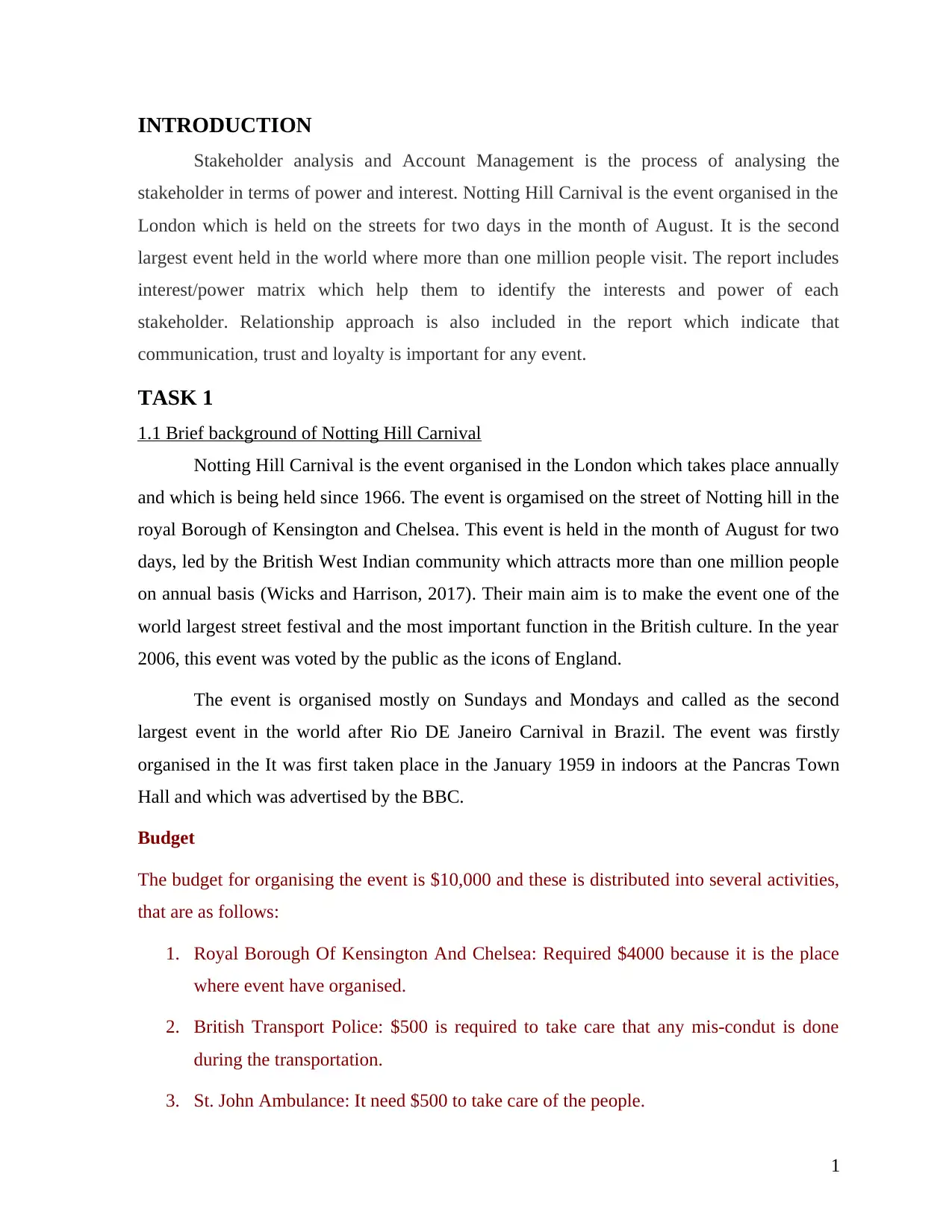
INTRODUCTION
Stakeholder analysis and Account Management is the process of analysing the
stakeholder in terms of power and interest. Notting Hill Carnival is the event organised in the
London which is held on the streets for two days in the month of August. It is the second
largest event held in the world where more than one million people visit. The report includes
interest/power matrix which help them to identify the interests and power of each
stakeholder. Relationship approach is also included in the report which indicate that
communication, trust and loyalty is important for any event.
TASK 1
1.1 Brief background of Notting Hill Carnival
Notting Hill Carnival is the event organised in the London which takes place annually
and which is being held since 1966. The event is orgamised on the street of Notting hill in the
royal Borough of Kensington and Chelsea. This event is held in the month of August for two
days, led by the British West Indian community which attracts more than one million people
on annual basis (Wicks and Harrison, 2017). Their main aim is to make the event one of the
world largest street festival and the most important function in the British culture. In the year
2006, this event was voted by the public as the icons of England.
The event is organised mostly on Sundays and Mondays and called as the second
largest event in the world after Rio DE Janeiro Carnival in Brazil. The event was firstly
organised in the It was first taken place in the January 1959 in indoors at the Pancras Town
Hall and which was advertised by the BBC.
Budget
The budget for organising the event is $10,000 and these is distributed into several activities,
that are as follows:
1. Royal Borough Of Kensington And Chelsea: Required $4000 because it is the place
where event have organised.
2. British Transport Police: $500 is required to take care that any mis-condut is done
during the transportation.
3. St. John Ambulance: It need $500 to take care of the people.
1
Stakeholder analysis and Account Management is the process of analysing the
stakeholder in terms of power and interest. Notting Hill Carnival is the event organised in the
London which is held on the streets for two days in the month of August. It is the second
largest event held in the world where more than one million people visit. The report includes
interest/power matrix which help them to identify the interests and power of each
stakeholder. Relationship approach is also included in the report which indicate that
communication, trust and loyalty is important for any event.
TASK 1
1.1 Brief background of Notting Hill Carnival
Notting Hill Carnival is the event organised in the London which takes place annually
and which is being held since 1966. The event is orgamised on the street of Notting hill in the
royal Borough of Kensington and Chelsea. This event is held in the month of August for two
days, led by the British West Indian community which attracts more than one million people
on annual basis (Wicks and Harrison, 2017). Their main aim is to make the event one of the
world largest street festival and the most important function in the British culture. In the year
2006, this event was voted by the public as the icons of England.
The event is organised mostly on Sundays and Mondays and called as the second
largest event in the world after Rio DE Janeiro Carnival in Brazil. The event was firstly
organised in the It was first taken place in the January 1959 in indoors at the Pancras Town
Hall and which was advertised by the BBC.
Budget
The budget for organising the event is $10,000 and these is distributed into several activities,
that are as follows:
1. Royal Borough Of Kensington And Chelsea: Required $4000 because it is the place
where event have organised.
2. British Transport Police: $500 is required to take care that any mis-condut is done
during the transportation.
3. St. John Ambulance: It need $500 to take care of the people.
1
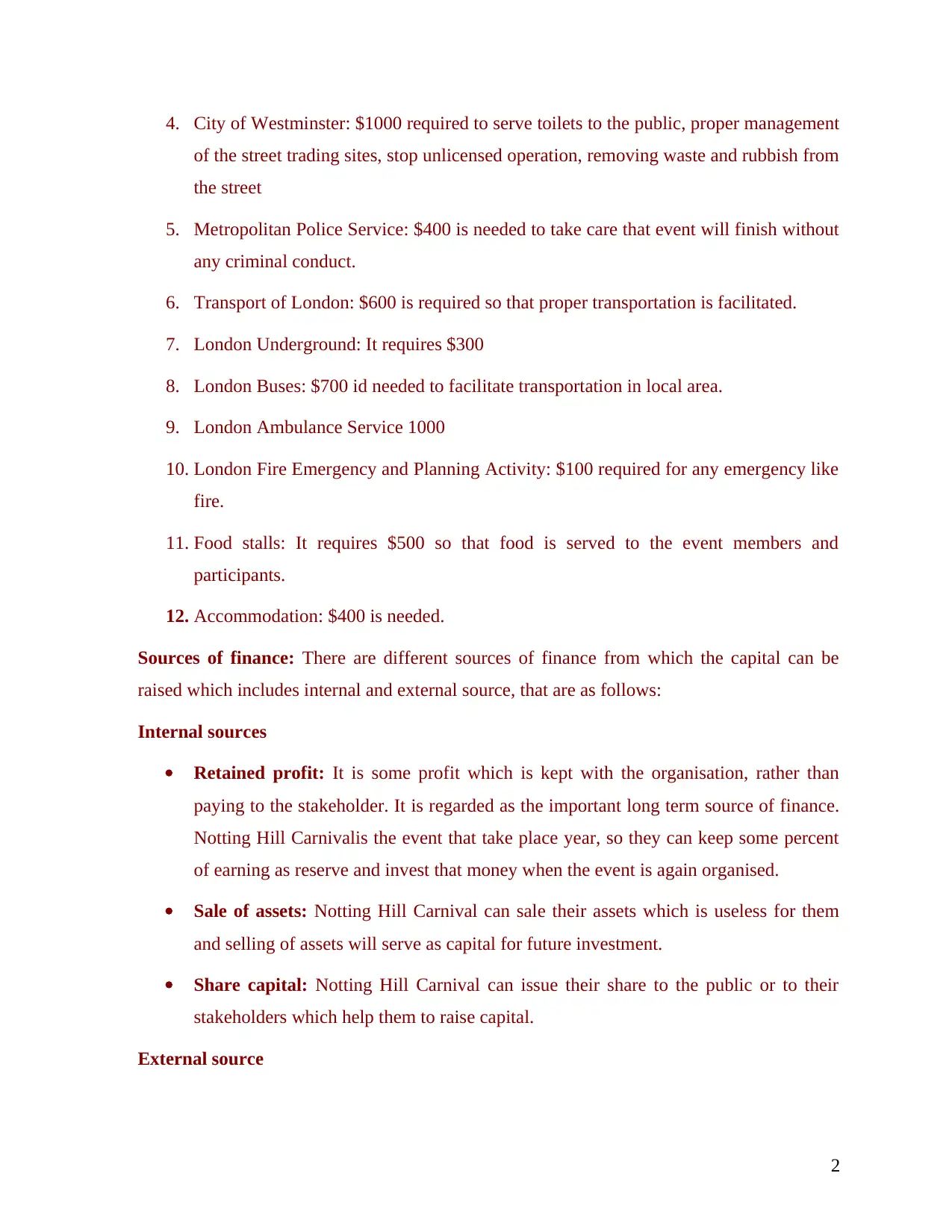
4. City of Westminster: $1000 required to serve toilets to the public, proper management
of the street trading sites, stop unlicensed operation, removing waste and rubbish from
the street
5. Metropolitan Police Service: $400 is needed to take care that event will finish without
any criminal conduct.
6. Transport of London: $600 is required so that proper transportation is facilitated.
7. London Underground: It requires $300
8. London Buses: $700 id needed to facilitate transportation in local area.
9. London Ambulance Service 1000
10. London Fire Emergency and Planning Activity: $100 required for any emergency like
fire.
11. Food stalls: It requires $500 so that food is served to the event members and
participants.
12. Accommodation: $400 is needed.
Sources of finance: There are different sources of finance from which the capital can be
raised which includes internal and external source, that are as follows:
Internal sources
Retained profit: It is some profit which is kept with the organisation, rather than
paying to the stakeholder. It is regarded as the important long term source of finance.
Notting Hill Carnivalis the event that take place year, so they can keep some percent
of earning as reserve and invest that money when the event is again organised.
Sale of assets: Notting Hill Carnival can sale their assets which is useless for them
and selling of assets will serve as capital for future investment.
Share capital: Notting Hill Carnival can issue their share to the public or to their
stakeholders which help them to raise capital.
External source
2
of the street trading sites, stop unlicensed operation, removing waste and rubbish from
the street
5. Metropolitan Police Service: $400 is needed to take care that event will finish without
any criminal conduct.
6. Transport of London: $600 is required so that proper transportation is facilitated.
7. London Underground: It requires $300
8. London Buses: $700 id needed to facilitate transportation in local area.
9. London Ambulance Service 1000
10. London Fire Emergency and Planning Activity: $100 required for any emergency like
fire.
11. Food stalls: It requires $500 so that food is served to the event members and
participants.
12. Accommodation: $400 is needed.
Sources of finance: There are different sources of finance from which the capital can be
raised which includes internal and external source, that are as follows:
Internal sources
Retained profit: It is some profit which is kept with the organisation, rather than
paying to the stakeholder. It is regarded as the important long term source of finance.
Notting Hill Carnivalis the event that take place year, so they can keep some percent
of earning as reserve and invest that money when the event is again organised.
Sale of assets: Notting Hill Carnival can sale their assets which is useless for them
and selling of assets will serve as capital for future investment.
Share capital: Notting Hill Carnival can issue their share to the public or to their
stakeholders which help them to raise capital.
External source
2
Secure Best Marks with AI Grader
Need help grading? Try our AI Grader for instant feedback on your assignments.
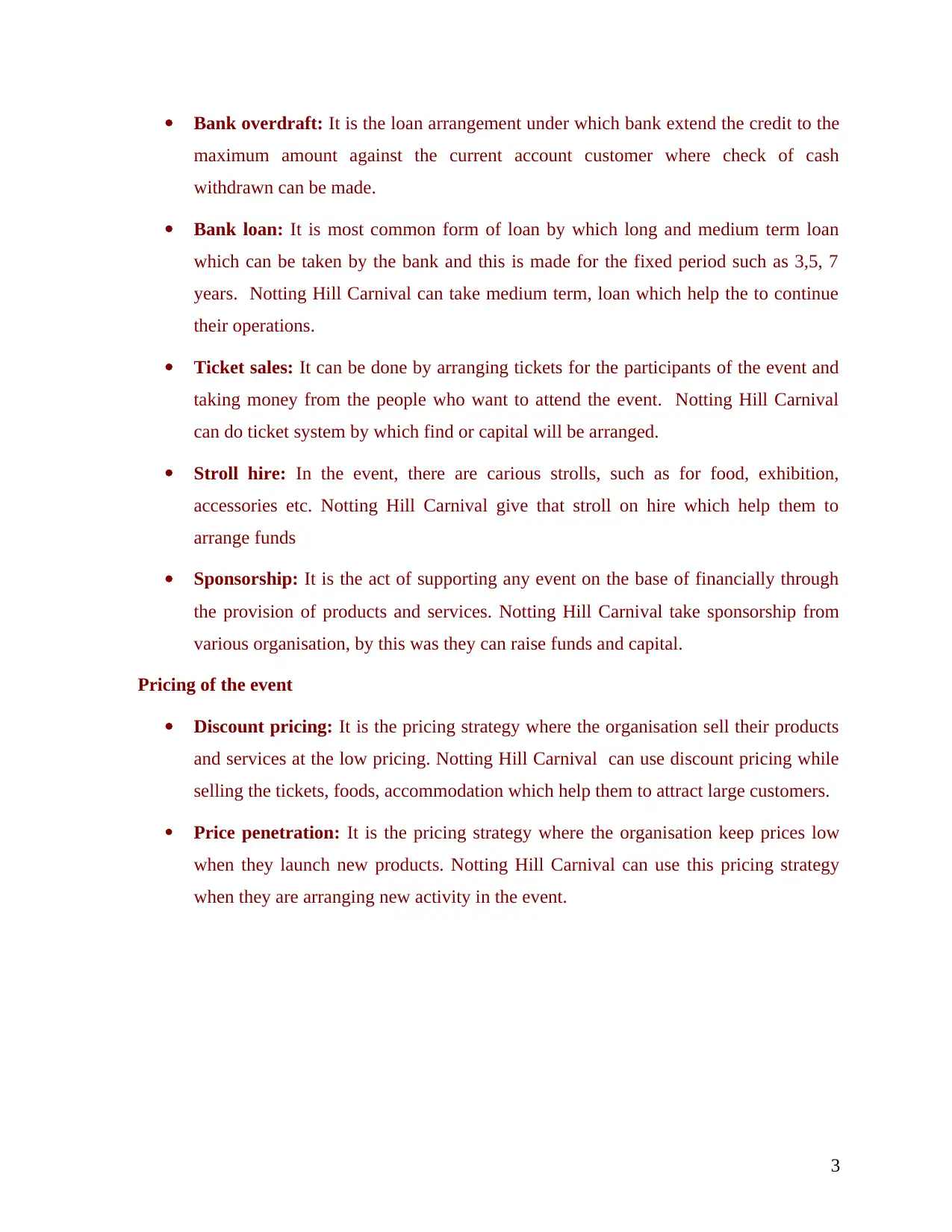
Bank overdraft: It is the loan arrangement under which bank extend the credit to the
maximum amount against the current account customer where check of cash
withdrawn can be made.
Bank loan: It is most common form of loan by which long and medium term loan
which can be taken by the bank and this is made for the fixed period such as 3,5, 7
years. Notting Hill Carnival can take medium term, loan which help the to continue
their operations.
Ticket sales: It can be done by arranging tickets for the participants of the event and
taking money from the people who want to attend the event. Notting Hill Carnival
can do ticket system by which find or capital will be arranged.
Stroll hire: In the event, there are carious strolls, such as for food, exhibition,
accessories etc. Notting Hill Carnival give that stroll on hire which help them to
arrange funds
Sponsorship: It is the act of supporting any event on the base of financially through
the provision of products and services. Notting Hill Carnival take sponsorship from
various organisation, by this was they can raise funds and capital.
Pricing of the event
Discount pricing: It is the pricing strategy where the organisation sell their products
and services at the low pricing. Notting Hill Carnival can use discount pricing while
selling the tickets, foods, accommodation which help them to attract large customers.
Price penetration: It is the pricing strategy where the organisation keep prices low
when they launch new products. Notting Hill Carnival can use this pricing strategy
when they are arranging new activity in the event.
3
maximum amount against the current account customer where check of cash
withdrawn can be made.
Bank loan: It is most common form of loan by which long and medium term loan
which can be taken by the bank and this is made for the fixed period such as 3,5, 7
years. Notting Hill Carnival can take medium term, loan which help the to continue
their operations.
Ticket sales: It can be done by arranging tickets for the participants of the event and
taking money from the people who want to attend the event. Notting Hill Carnival
can do ticket system by which find or capital will be arranged.
Stroll hire: In the event, there are carious strolls, such as for food, exhibition,
accessories etc. Notting Hill Carnival give that stroll on hire which help them to
arrange funds
Sponsorship: It is the act of supporting any event on the base of financially through
the provision of products and services. Notting Hill Carnival take sponsorship from
various organisation, by this was they can raise funds and capital.
Pricing of the event
Discount pricing: It is the pricing strategy where the organisation sell their products
and services at the low pricing. Notting Hill Carnival can use discount pricing while
selling the tickets, foods, accommodation which help them to attract large customers.
Price penetration: It is the pricing strategy where the organisation keep prices low
when they launch new products. Notting Hill Carnival can use this pricing strategy
when they are arranging new activity in the event.
3
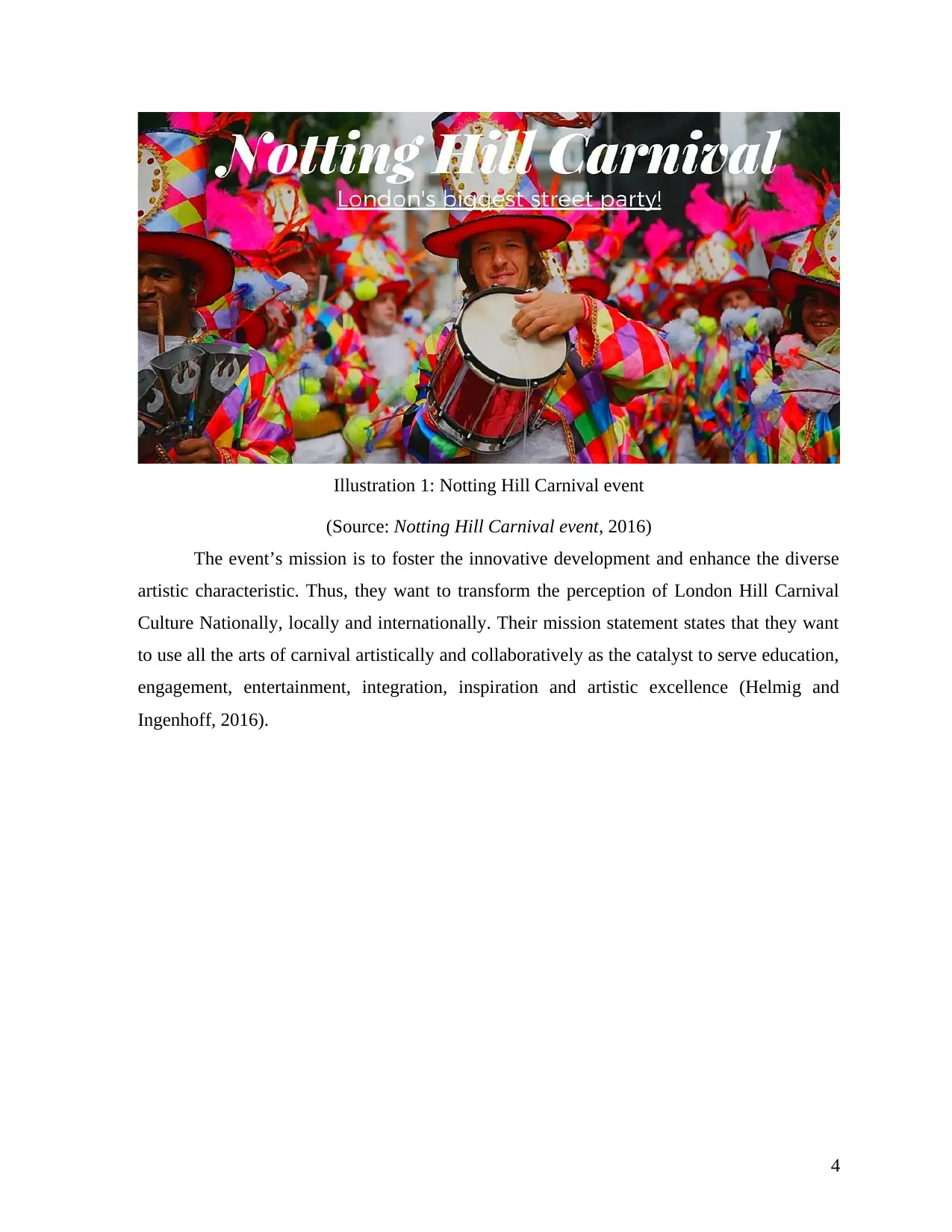
Illustration 1: Notting Hill Carnival event
(Source: Notting Hill Carnival event, 2016)
The event’s mission is to foster the innovative development and enhance the diverse
artistic characteristic. Thus, they want to transform the perception of London Hill Carnival
Culture Nationally, locally and internationally. Their mission statement states that they want
to use all the arts of carnival artistically and collaboratively as the catalyst to serve education,
engagement, entertainment, integration, inspiration and artistic excellence (Helmig and
Ingenhoff, 2016).
4
(Source: Notting Hill Carnival event, 2016)
The event’s mission is to foster the innovative development and enhance the diverse
artistic characteristic. Thus, they want to transform the perception of London Hill Carnival
Culture Nationally, locally and internationally. Their mission statement states that they want
to use all the arts of carnival artistically and collaboratively as the catalyst to serve education,
engagement, entertainment, integration, inspiration and artistic excellence (Helmig and
Ingenhoff, 2016).
4
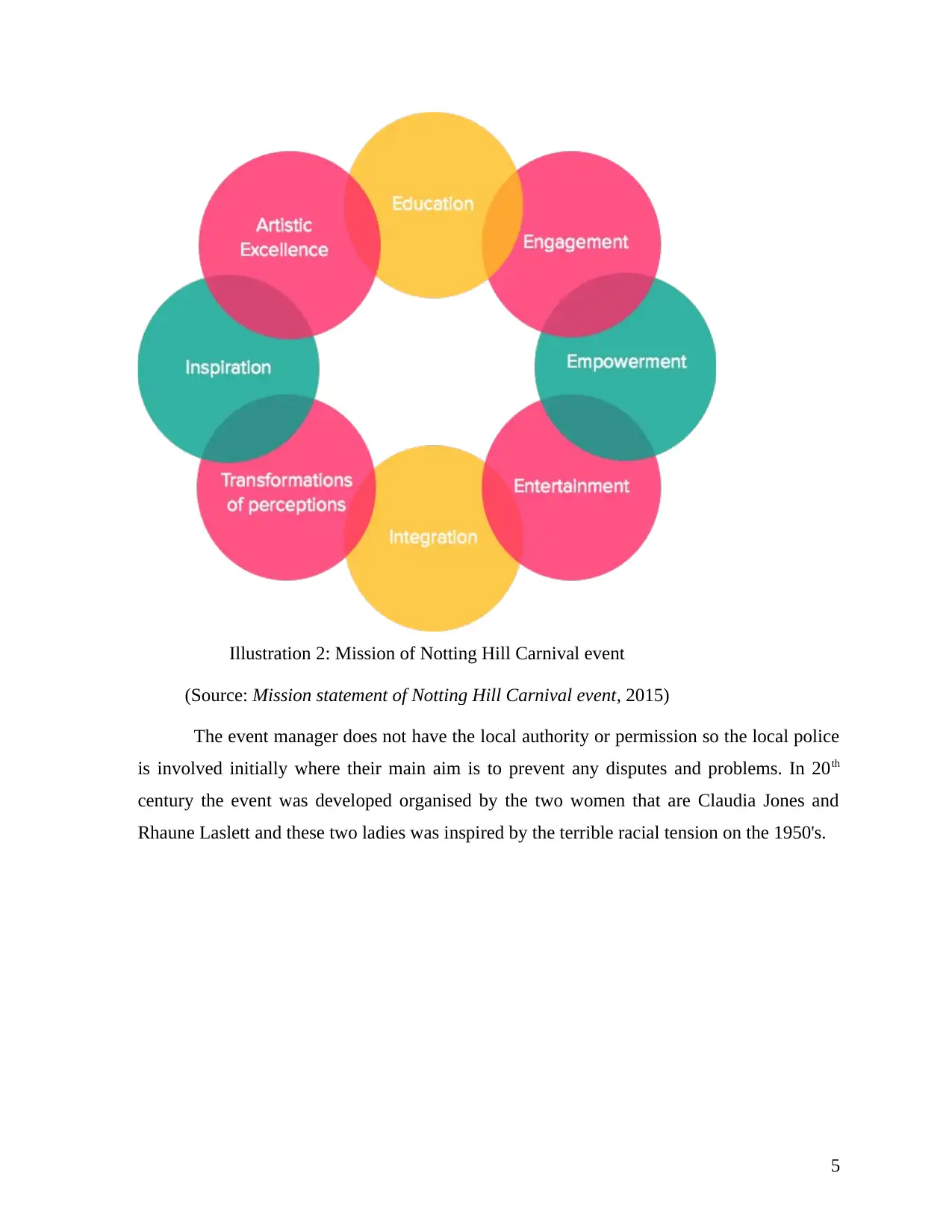
Illustration 2: Mission of Notting Hill Carnival event
(Source: Mission statement of Notting Hill Carnival event, 2015)
The event manager does not have the local authority or permission so the local police
is involved initially where their main aim is to prevent any disputes and problems. In 20th
century the event was developed organised by the two women that are Claudia Jones and
Rhaune Laslett and these two ladies was inspired by the terrible racial tension on the 1950's.
5
(Source: Mission statement of Notting Hill Carnival event, 2015)
The event manager does not have the local authority or permission so the local police
is involved initially where their main aim is to prevent any disputes and problems. In 20th
century the event was developed organised by the two women that are Claudia Jones and
Rhaune Laslett and these two ladies was inspired by the terrible racial tension on the 1950's.
5
Paraphrase This Document
Need a fresh take? Get an instant paraphrase of this document with our AI Paraphraser
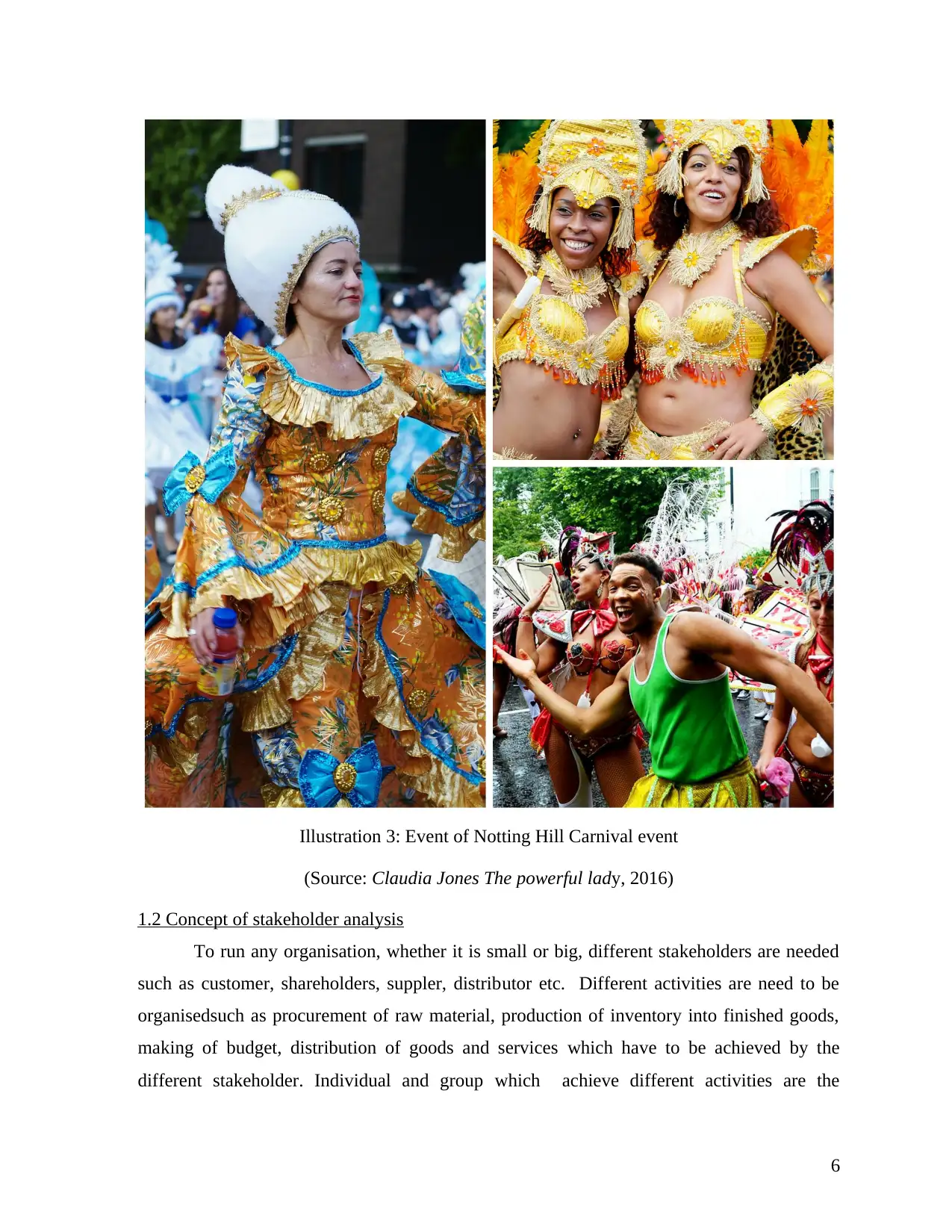
Illustration 3: Event of Notting Hill Carnival event
(Source: Claudia Jones The powerful lady, 2016)
1.2 Concept of stakeholder analysis
To run any organisation, whether it is small or big, different stakeholders are needed
such as customer, shareholders, suppler, distributor etc. Different activities are need to be
organisedsuch as procurement of raw material, production of inventory into finished goods,
making of budget, distribution of goods and services which have to be achieved by the
different stakeholder. Individual and group which achieve different activities are the
6
(Source: Claudia Jones The powerful lady, 2016)
1.2 Concept of stakeholder analysis
To run any organisation, whether it is small or big, different stakeholders are needed
such as customer, shareholders, suppler, distributor etc. Different activities are need to be
organisedsuch as procurement of raw material, production of inventory into finished goods,
making of budget, distribution of goods and services which have to be achieved by the
different stakeholder. Individual and group which achieve different activities are the
6
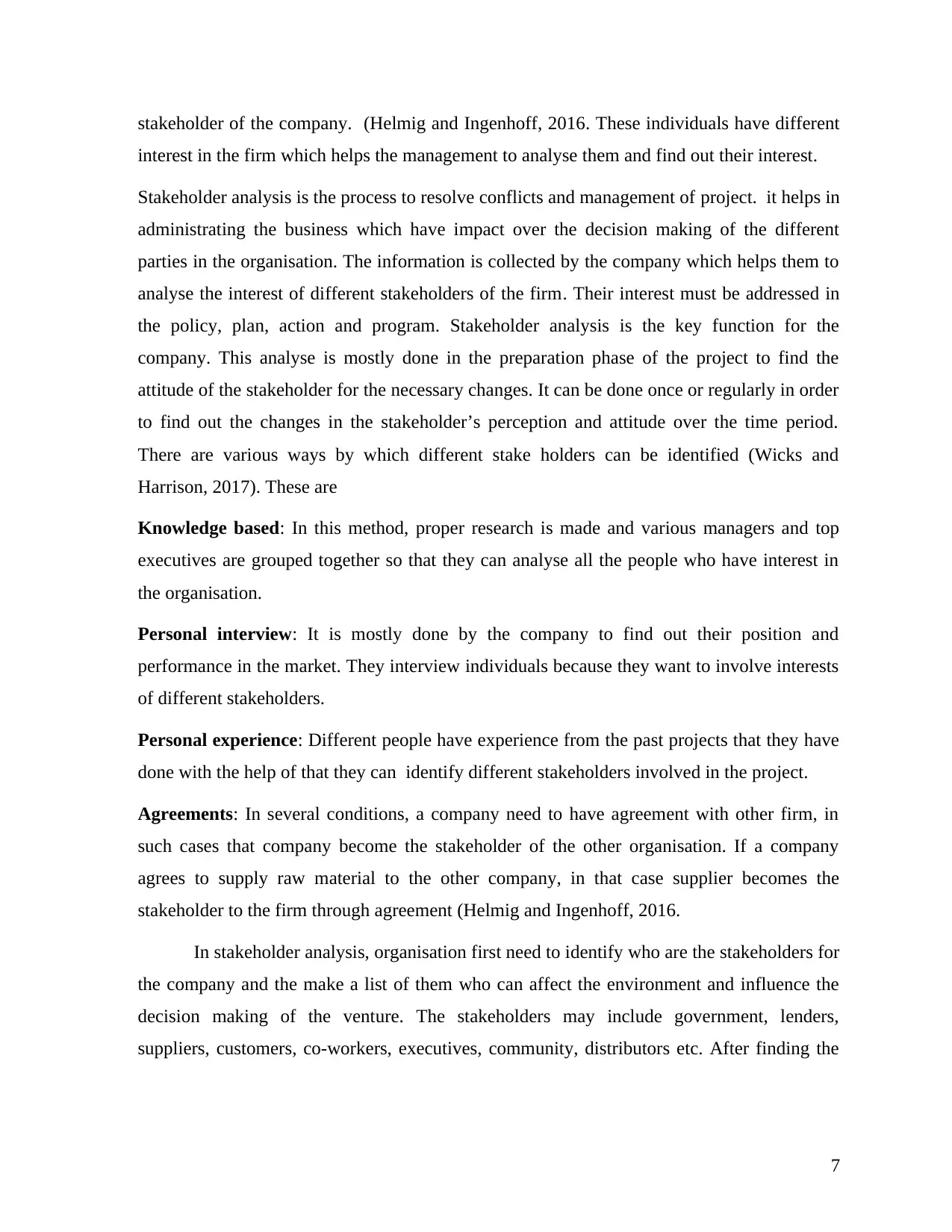
stakeholder of the company. (Helmig and Ingenhoff, 2016. These individuals have different
interest in the firm which helps the management to analyse them and find out their interest.
Stakeholder analysis is the process to resolve conflicts and management of project. it helps in
administrating the business which have impact over the decision making of the different
parties in the organisation. The information is collected by the company which helps them to
analyse the interest of different stakeholders of the firm. Their interest must be addressed in
the policy, plan, action and program. Stakeholder analysis is the key function for the
company. This analyse is mostly done in the preparation phase of the project to find the
attitude of the stakeholder for the necessary changes. It can be done once or regularly in order
to find out the changes in the stakeholder’s perception and attitude over the time period.
There are various ways by which different stake holders can be identified (Wicks and
Harrison, 2017). These are
Knowledge based: In this method, proper research is made and various managers and top
executives are grouped together so that they can analyse all the people who have interest in
the organisation.
Personal interview: It is mostly done by the company to find out their position and
performance in the market. They interview individuals because they want to involve interests
of different stakeholders.
Personal experience: Different people have experience from the past projects that they have
done with the help of that they can identify different stakeholders involved in the project.
Agreements: In several conditions, a company need to have agreement with other firm, in
such cases that company become the stakeholder of the other organisation. If a company
agrees to supply raw material to the other company, in that case supplier becomes the
stakeholder to the firm through agreement (Helmig and Ingenhoff, 2016.
In stakeholder analysis, organisation first need to identify who are the stakeholders for
the company and the make a list of them who can affect the environment and influence the
decision making of the venture. The stakeholders may include government, lenders,
suppliers, customers, co-workers, executives, community, distributors etc. After finding the
7
interest in the firm which helps the management to analyse them and find out their interest.
Stakeholder analysis is the process to resolve conflicts and management of project. it helps in
administrating the business which have impact over the decision making of the different
parties in the organisation. The information is collected by the company which helps them to
analyse the interest of different stakeholders of the firm. Their interest must be addressed in
the policy, plan, action and program. Stakeholder analysis is the key function for the
company. This analyse is mostly done in the preparation phase of the project to find the
attitude of the stakeholder for the necessary changes. It can be done once or regularly in order
to find out the changes in the stakeholder’s perception and attitude over the time period.
There are various ways by which different stake holders can be identified (Wicks and
Harrison, 2017). These are
Knowledge based: In this method, proper research is made and various managers and top
executives are grouped together so that they can analyse all the people who have interest in
the organisation.
Personal interview: It is mostly done by the company to find out their position and
performance in the market. They interview individuals because they want to involve interests
of different stakeholders.
Personal experience: Different people have experience from the past projects that they have
done with the help of that they can identify different stakeholders involved in the project.
Agreements: In several conditions, a company need to have agreement with other firm, in
such cases that company become the stakeholder of the other organisation. If a company
agrees to supply raw material to the other company, in that case supplier becomes the
stakeholder to the firm through agreement (Helmig and Ingenhoff, 2016.
In stakeholder analysis, organisation first need to identify who are the stakeholders for
the company and the make a list of them who can affect the environment and influence the
decision making of the venture. The stakeholders may include government, lenders,
suppliers, customers, co-workers, executives, community, distributors etc. After finding the
7
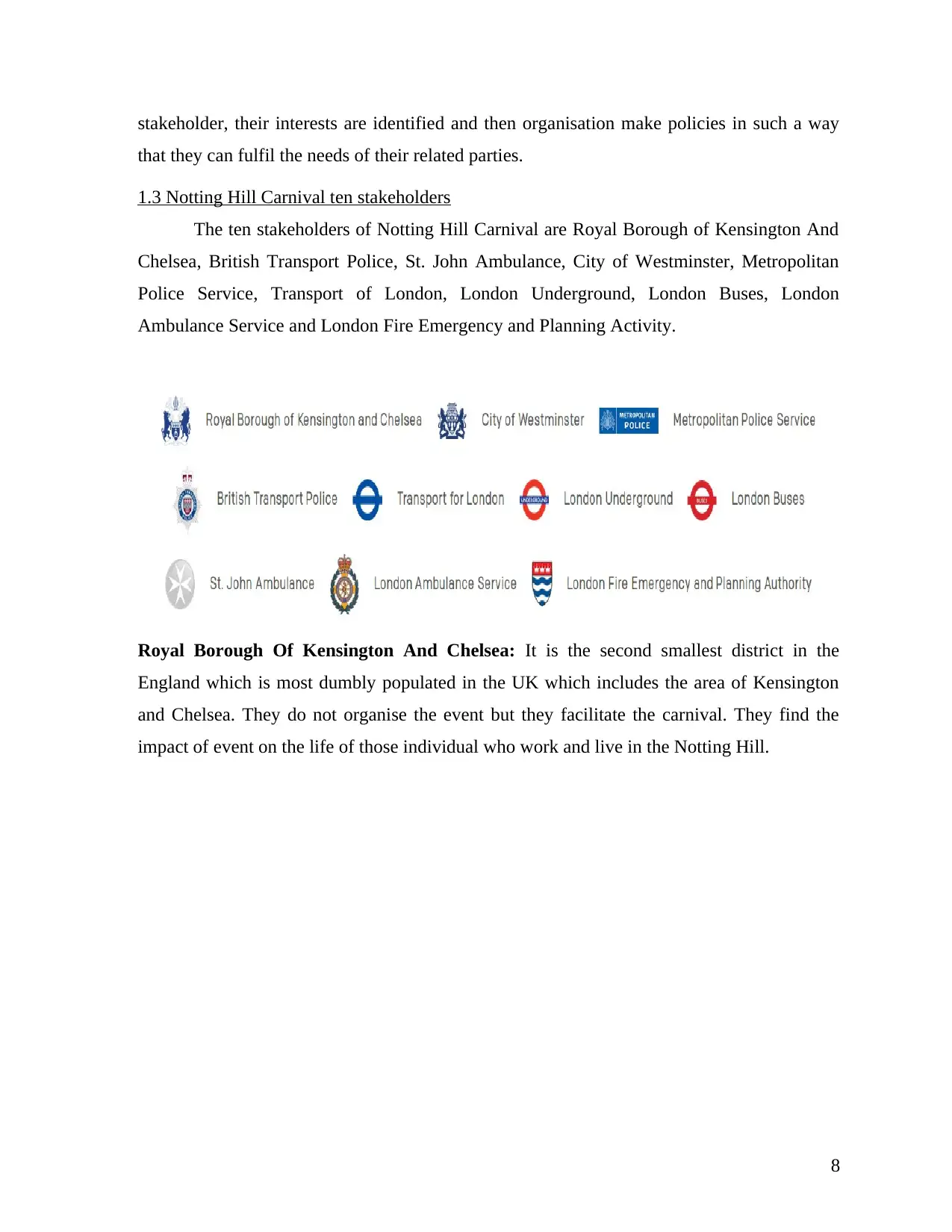
stakeholder, their interests are identified and then organisation make policies in such a way
that they can fulfil the needs of their related parties.
1.3 Notting Hill Carnival ten stakeholders
The ten stakeholders of Notting Hill Carnival are Royal Borough of Kensington And
Chelsea, British Transport Police, St. John Ambulance, City of Westminster, Metropolitan
Police Service, Transport of London, London Underground, London Buses, London
Ambulance Service and London Fire Emergency and Planning Activity.
Royal Borough Of Kensington And Chelsea: It is the second smallest district in the
England which is most dumbly populated in the UK which includes the area of Kensington
and Chelsea. They do not organise the event but they facilitate the carnival. They find the
impact of event on the life of those individual who work and live in the Notting Hill.
8
that they can fulfil the needs of their related parties.
1.3 Notting Hill Carnival ten stakeholders
The ten stakeholders of Notting Hill Carnival are Royal Borough of Kensington And
Chelsea, British Transport Police, St. John Ambulance, City of Westminster, Metropolitan
Police Service, Transport of London, London Underground, London Buses, London
Ambulance Service and London Fire Emergency and Planning Activity.
Royal Borough Of Kensington And Chelsea: It is the second smallest district in the
England which is most dumbly populated in the UK which includes the area of Kensington
and Chelsea. They do not organise the event but they facilitate the carnival. They find the
impact of event on the life of those individual who work and live in the Notting Hill.
8
Secure Best Marks with AI Grader
Need help grading? Try our AI Grader for instant feedback on your assignments.
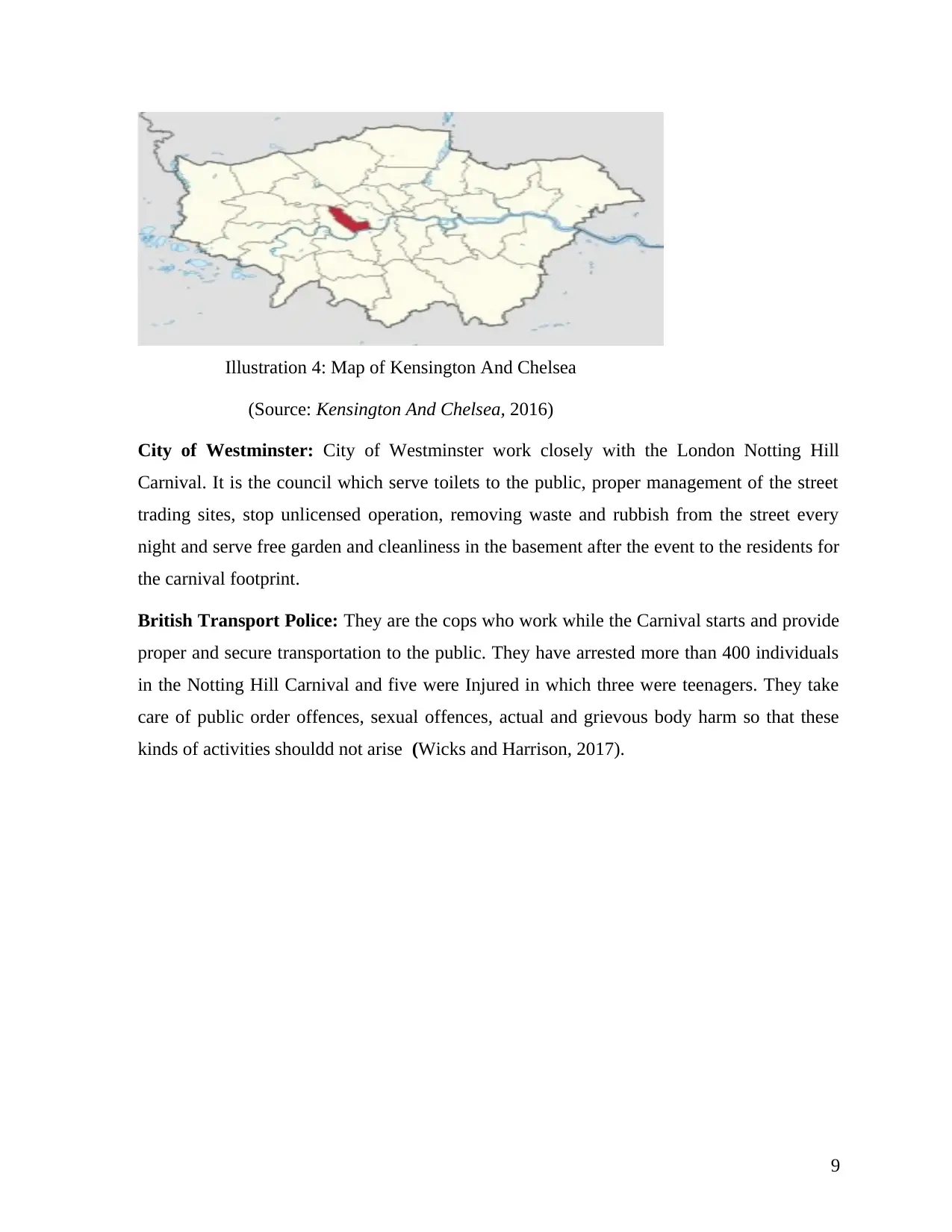
Illustration 4: Map of Kensington And Chelsea
(Source: Kensington And Chelsea, 2016)
City of Westminster: City of Westminster work closely with the London Notting Hill
Carnival. It is the council which serve toilets to the public, proper management of the street
trading sites, stop unlicensed operation, removing waste and rubbish from the street every
night and serve free garden and cleanliness in the basement after the event to the residents for
the carnival footprint.
British Transport Police: They are the cops who work while the Carnival starts and provide
proper and secure transportation to the public. They have arrested more than 400 individuals
in the Notting Hill Carnival and five were Injured in which three were teenagers. They take
care of public order offences, sexual offences, actual and grievous body harm so that these
kinds of activities shouldd not arise (Wicks and Harrison, 2017).
9
(Source: Kensington And Chelsea, 2016)
City of Westminster: City of Westminster work closely with the London Notting Hill
Carnival. It is the council which serve toilets to the public, proper management of the street
trading sites, stop unlicensed operation, removing waste and rubbish from the street every
night and serve free garden and cleanliness in the basement after the event to the residents for
the carnival footprint.
British Transport Police: They are the cops who work while the Carnival starts and provide
proper and secure transportation to the public. They have arrested more than 400 individuals
in the Notting Hill Carnival and five were Injured in which three were teenagers. They take
care of public order offences, sexual offences, actual and grievous body harm so that these
kinds of activities shouldd not arise (Wicks and Harrison, 2017).
9
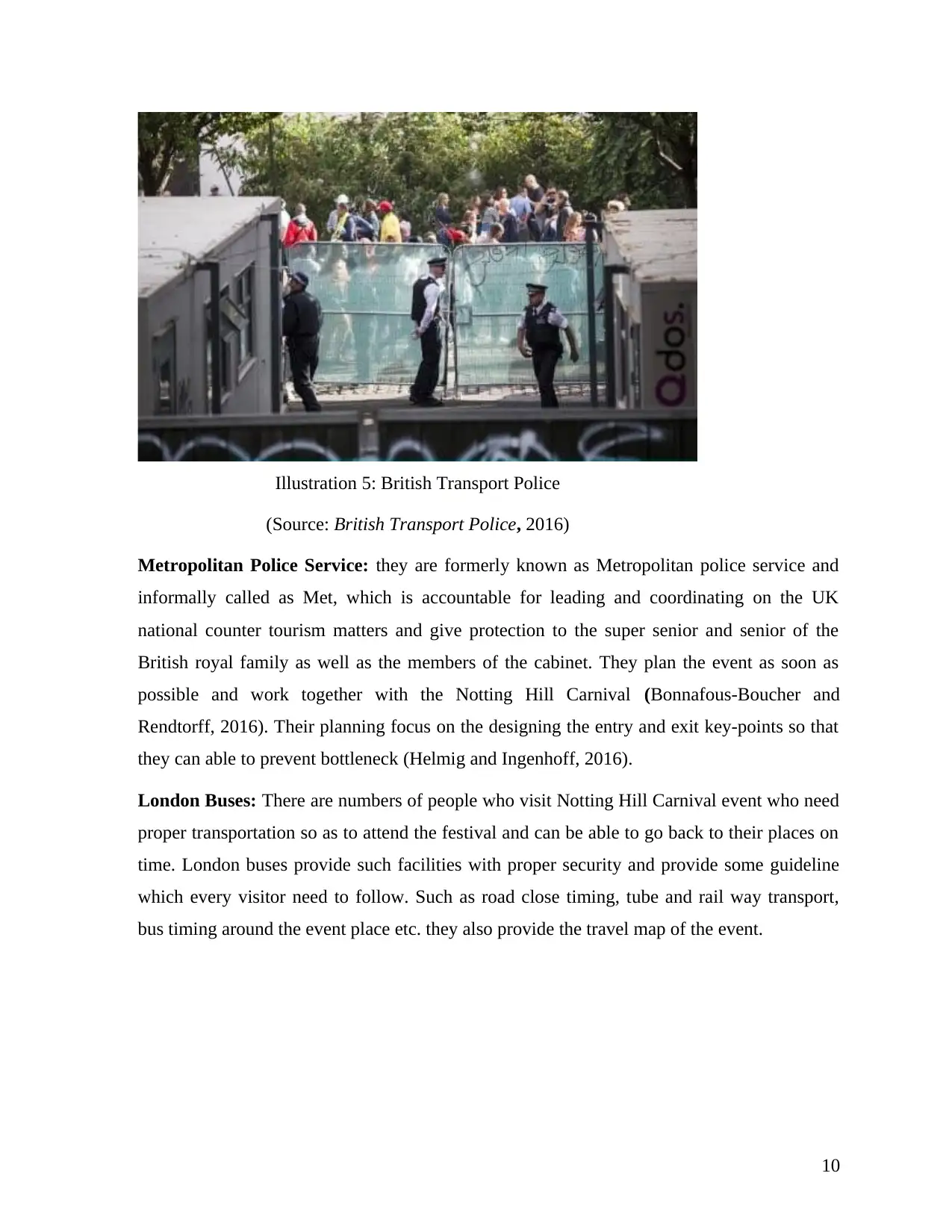
Illustration 5: British Transport Police
(Source: British Transport Police, 2016)
Metropolitan Police Service: they are formerly known as Metropolitan police service and
informally called as Met, which is accountable for leading and coordinating on the UK
national counter tourism matters and give protection to the super senior and senior of the
British royal family as well as the members of the cabinet. They plan the event as soon as
possible and work together with the Notting Hill Carnival (Bonnafous-Boucher and
Rendtorff, 2016). Their planning focus on the designing the entry and exit key-points so that
they can able to prevent bottleneck (Helmig and Ingenhoff, 2016).
London Buses: There are numbers of people who visit Notting Hill Carnival event who need
proper transportation so as to attend the festival and can be able to go back to their places on
time. London buses provide such facilities with proper security and provide some guideline
which every visitor need to follow. Such as road close timing, tube and rail way transport,
bus timing around the event place etc. they also provide the travel map of the event.
10
(Source: British Transport Police, 2016)
Metropolitan Police Service: they are formerly known as Metropolitan police service and
informally called as Met, which is accountable for leading and coordinating on the UK
national counter tourism matters and give protection to the super senior and senior of the
British royal family as well as the members of the cabinet. They plan the event as soon as
possible and work together with the Notting Hill Carnival (Bonnafous-Boucher and
Rendtorff, 2016). Their planning focus on the designing the entry and exit key-points so that
they can able to prevent bottleneck (Helmig and Ingenhoff, 2016).
London Buses: There are numbers of people who visit Notting Hill Carnival event who need
proper transportation so as to attend the festival and can be able to go back to their places on
time. London buses provide such facilities with proper security and provide some guideline
which every visitor need to follow. Such as road close timing, tube and rail way transport,
bus timing around the event place etc. they also provide the travel map of the event.
10

Illustration 6: London Buses
(Source: London Buses, 2017)
London Ambulance Service: There are several teams made. Each team is made up of a
paramedic, an emergency medical technician and a SJA volunteer, who will work on foot
with full medical equipment including a defibrillator, oxygen and a carry sheet which can be
used as a stretcher (Wicks and Harrison, 2017).
1.4 Interests of each identified stakeholder
There are several stakeholders who are involved in the event of Notting Hill Carnival
so that event can be organised successfully and no hurdles will arise. It is an international
level street event organised where more than one million people participate. To manage them
different shareholders are needed such as British police, ambulance etc. every stakeholder has
different interest in the program.
Royal Borough of Kensington And Chelsea is the place where the event has been
organised, they need that their tradition and culture should be explored so that more visitor
11
(Source: London Buses, 2017)
London Ambulance Service: There are several teams made. Each team is made up of a
paramedic, an emergency medical technician and a SJA volunteer, who will work on foot
with full medical equipment including a defibrillator, oxygen and a carry sheet which can be
used as a stretcher (Wicks and Harrison, 2017).
1.4 Interests of each identified stakeholder
There are several stakeholders who are involved in the event of Notting Hill Carnival
so that event can be organised successfully and no hurdles will arise. It is an international
level street event organised where more than one million people participate. To manage them
different shareholders are needed such as British police, ambulance etc. every stakeholder has
different interest in the program.
Royal Borough of Kensington And Chelsea is the place where the event has been
organised, they need that their tradition and culture should be explored so that more visitor
11
Paraphrase This Document
Need a fresh take? Get an instant paraphrase of this document with our AI Paraphraser
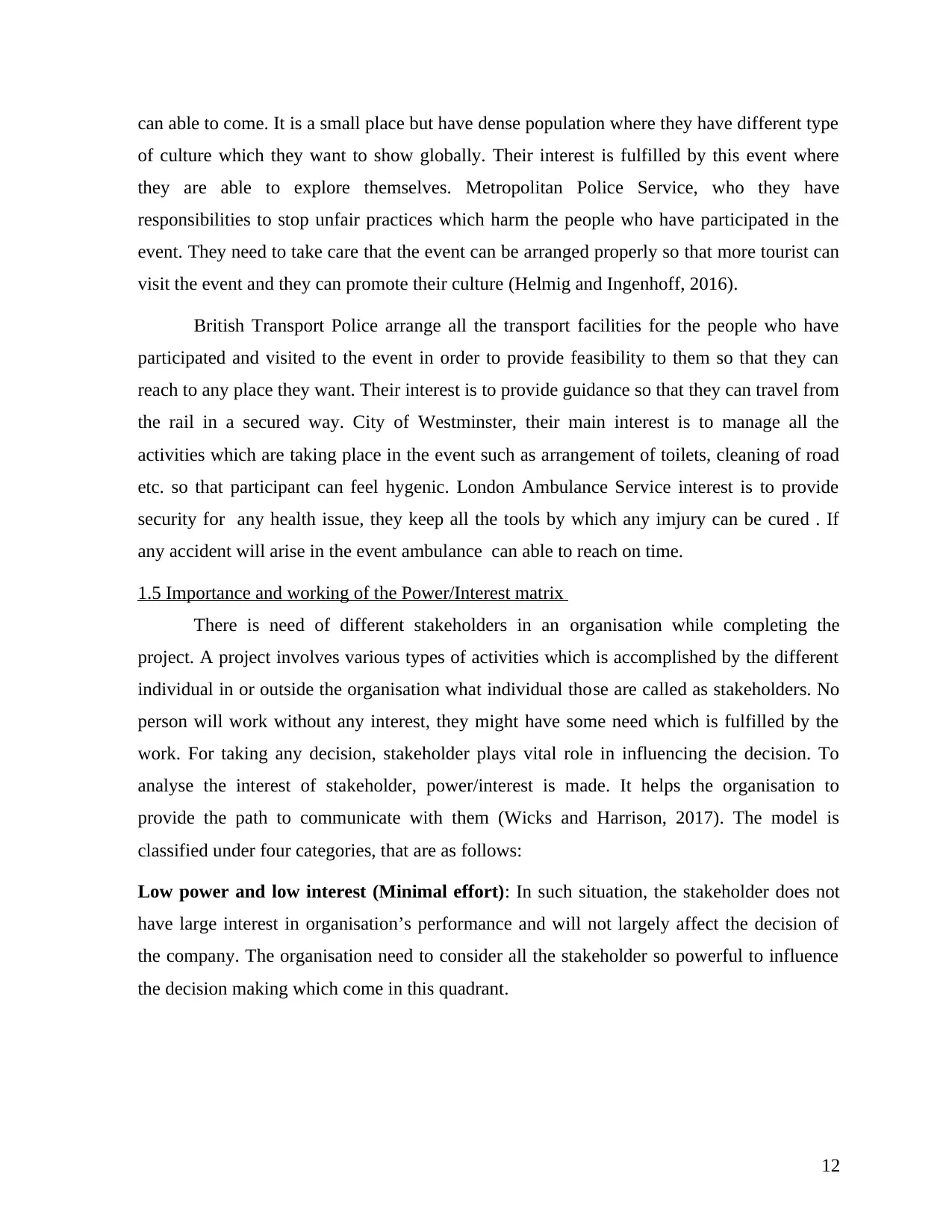
can able to come. It is a small place but have dense population where they have different type
of culture which they want to show globally. Their interest is fulfilled by this event where
they are able to explore themselves. Metropolitan Police Service, who they have
responsibilities to stop unfair practices which harm the people who have participated in the
event. They need to take care that the event can be arranged properly so that more tourist can
visit the event and they can promote their culture (Helmig and Ingenhoff, 2016).
British Transport Police arrange all the transport facilities for the people who have
participated and visited to the event in order to provide feasibility to them so that they can
reach to any place they want. Their interest is to provide guidance so that they can travel from
the rail in a secured way. City of Westminster, their main interest is to manage all the
activities which are taking place in the event such as arrangement of toilets, cleaning of road
etc. so that participant can feel hygenic. London Ambulance Service interest is to provide
security for any health issue, they keep all the tools by which any imjury can be cured . If
any accident will arise in the event ambulance can able to reach on time.
1.5 Importance and working of the Power/Interest matrix
There is need of different stakeholders in an organisation while completing the
project. A project involves various types of activities which is accomplished by the different
individual in or outside the organisation what individual those are called as stakeholders. No
person will work without any interest, they might have some need which is fulfilled by the
work. For taking any decision, stakeholder plays vital role in influencing the decision. To
analyse the interest of stakeholder, power/interest is made. It helps the organisation to
provide the path to communicate with them (Wicks and Harrison, 2017). The model is
classified under four categories, that are as follows:
Low power and low interest (Minimal effort): In such situation, the stakeholder does not
have large interest in organisation’s performance and will not largely affect the decision of
the company. The organisation need to consider all the stakeholder so powerful to influence
the decision making which come in this quadrant.
12
of culture which they want to show globally. Their interest is fulfilled by this event where
they are able to explore themselves. Metropolitan Police Service, who they have
responsibilities to stop unfair practices which harm the people who have participated in the
event. They need to take care that the event can be arranged properly so that more tourist can
visit the event and they can promote their culture (Helmig and Ingenhoff, 2016).
British Transport Police arrange all the transport facilities for the people who have
participated and visited to the event in order to provide feasibility to them so that they can
reach to any place they want. Their interest is to provide guidance so that they can travel from
the rail in a secured way. City of Westminster, their main interest is to manage all the
activities which are taking place in the event such as arrangement of toilets, cleaning of road
etc. so that participant can feel hygenic. London Ambulance Service interest is to provide
security for any health issue, they keep all the tools by which any imjury can be cured . If
any accident will arise in the event ambulance can able to reach on time.
1.5 Importance and working of the Power/Interest matrix
There is need of different stakeholders in an organisation while completing the
project. A project involves various types of activities which is accomplished by the different
individual in or outside the organisation what individual those are called as stakeholders. No
person will work without any interest, they might have some need which is fulfilled by the
work. For taking any decision, stakeholder plays vital role in influencing the decision. To
analyse the interest of stakeholder, power/interest is made. It helps the organisation to
provide the path to communicate with them (Wicks and Harrison, 2017). The model is
classified under four categories, that are as follows:
Low power and low interest (Minimal effort): In such situation, the stakeholder does not
have large interest in organisation’s performance and will not largely affect the decision of
the company. The organisation need to consider all the stakeholder so powerful to influence
the decision making which come in this quadrant.
12
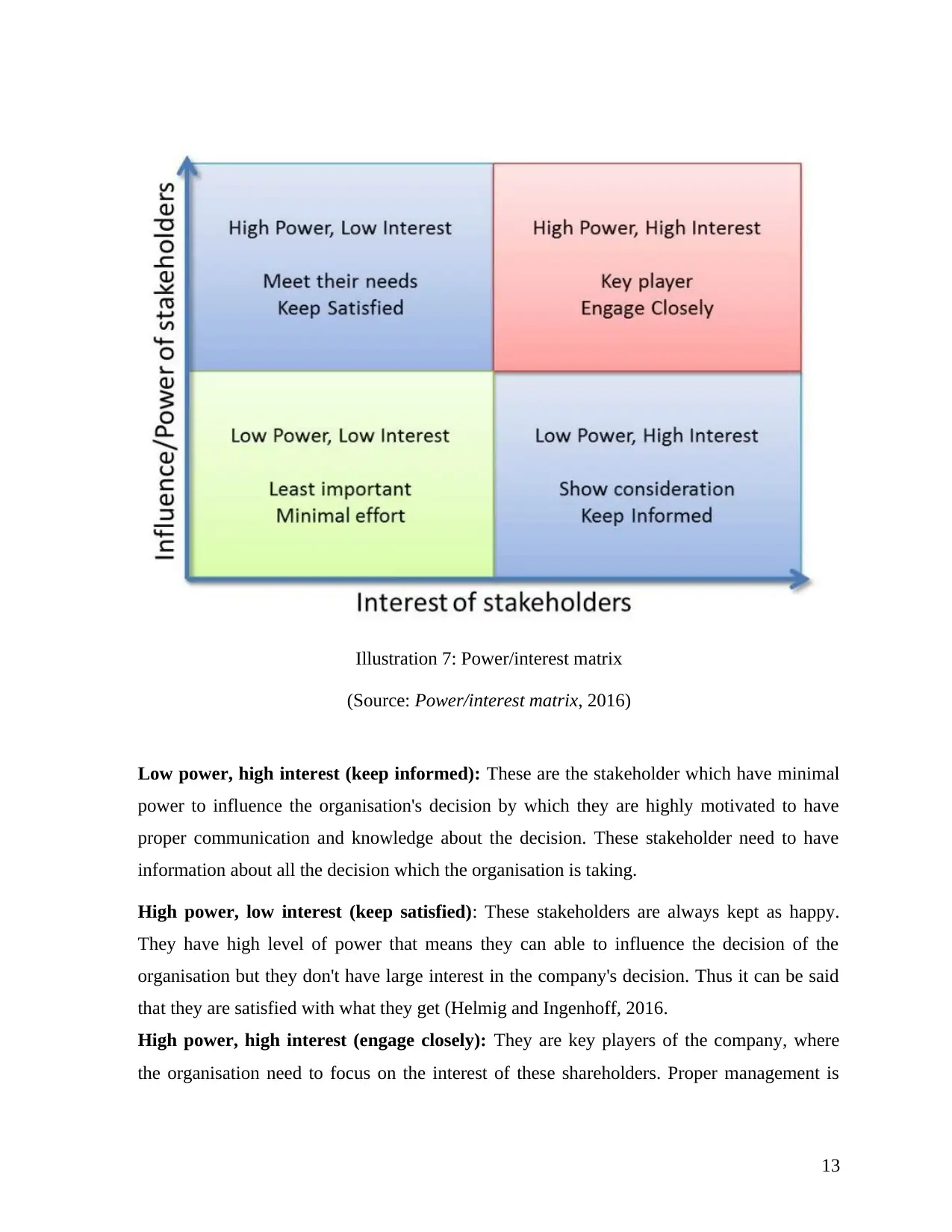
Low power, high interest (keep informed): These are the stakeholder which have minimal
power to influence the organisation's decision by which they are highly motivated to have
proper communication and knowledge about the decision. These stakeholder need to have
information about all the decision which the organisation is taking.
High power, low interest (keep satisfied): These stakeholders are always kept as happy.
They have high level of power that means they can able to influence the decision of the
organisation but they don't have large interest in the company's decision. Thus it can be said
that they are satisfied with what they get (Helmig and Ingenhoff, 2016.
High power, high interest (engage closely): They are key players of the company, where
the organisation need to focus on the interest of these shareholders. Proper management is
13
Illustration 7: Power/interest matrix
(Source: Power/interest matrix, 2016)
power to influence the organisation's decision by which they are highly motivated to have
proper communication and knowledge about the decision. These stakeholder need to have
information about all the decision which the organisation is taking.
High power, low interest (keep satisfied): These stakeholders are always kept as happy.
They have high level of power that means they can able to influence the decision of the
organisation but they don't have large interest in the company's decision. Thus it can be said
that they are satisfied with what they get (Helmig and Ingenhoff, 2016.
High power, high interest (engage closely): They are key players of the company, where
the organisation need to focus on the interest of these shareholders. Proper management is
13
Illustration 7: Power/interest matrix
(Source: Power/interest matrix, 2016)
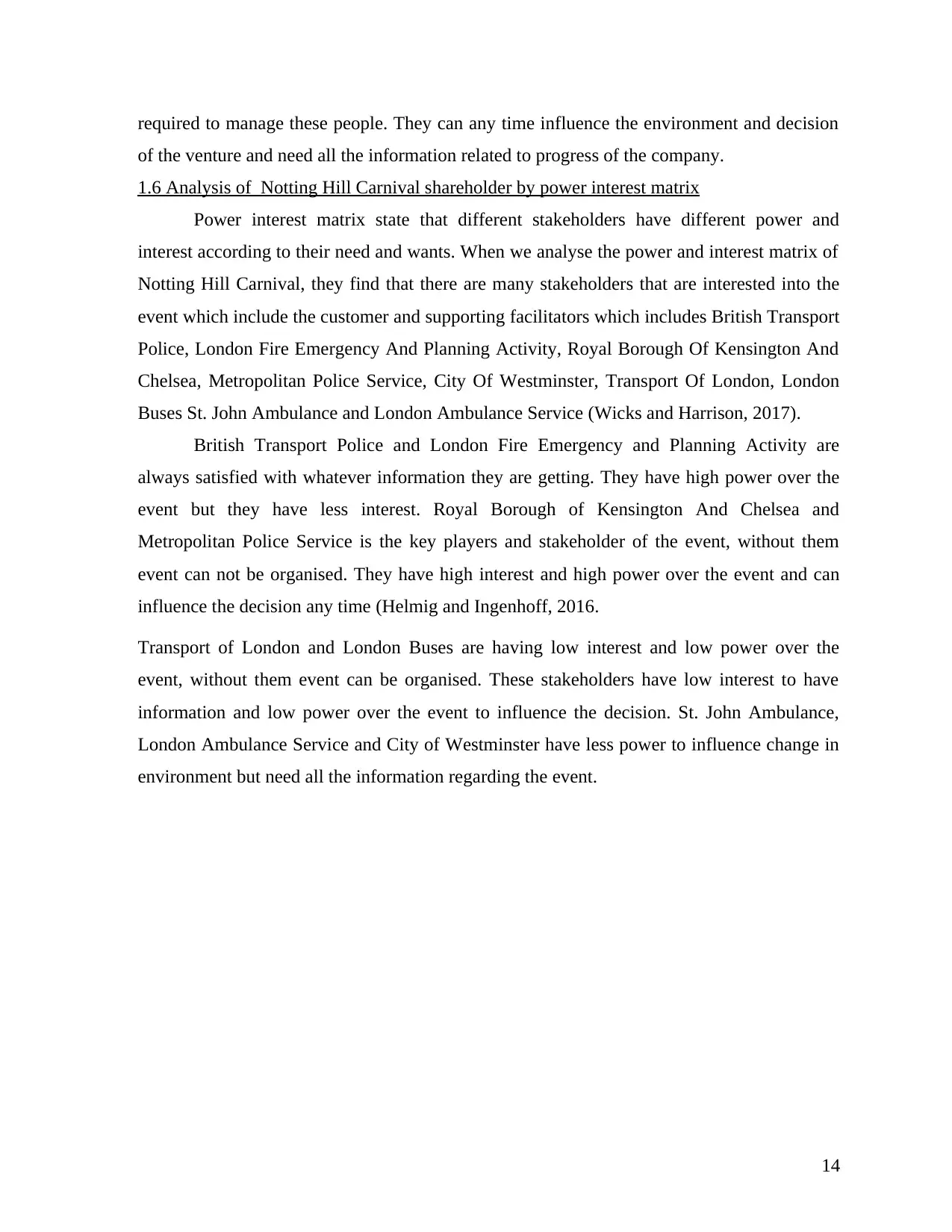
required to manage these people. They can any time influence the environment and decision
of the venture and need all the information related to progress of the company.
1.6 Analysis of Notting Hill Carnival shareholder by power interest matrix
Power interest matrix state that different stakeholders have different power and
interest according to their need and wants. When we analyse the power and interest matrix of
Notting Hill Carnival, they find that there are many stakeholders that are interested into the
event which include the customer and supporting facilitators which includes British Transport
Police, London Fire Emergency And Planning Activity, Royal Borough Of Kensington And
Chelsea, Metropolitan Police Service, City Of Westminster, Transport Of London, London
Buses St. John Ambulance and London Ambulance Service (Wicks and Harrison, 2017).
British Transport Police and London Fire Emergency and Planning Activity are
always satisfied with whatever information they are getting. They have high power over the
event but they have less interest. Royal Borough of Kensington And Chelsea and
Metropolitan Police Service is the key players and stakeholder of the event, without them
event can not be organised. They have high interest and high power over the event and can
influence the decision any time (Helmig and Ingenhoff, 2016.
Transport of London and London Buses are having low interest and low power over the
event, without them event can be organised. These stakeholders have low interest to have
information and low power over the event to influence the decision. St. John Ambulance,
London Ambulance Service and City of Westminster have less power to influence change in
environment but need all the information regarding the event.
14
of the venture and need all the information related to progress of the company.
1.6 Analysis of Notting Hill Carnival shareholder by power interest matrix
Power interest matrix state that different stakeholders have different power and
interest according to their need and wants. When we analyse the power and interest matrix of
Notting Hill Carnival, they find that there are many stakeholders that are interested into the
event which include the customer and supporting facilitators which includes British Transport
Police, London Fire Emergency And Planning Activity, Royal Borough Of Kensington And
Chelsea, Metropolitan Police Service, City Of Westminster, Transport Of London, London
Buses St. John Ambulance and London Ambulance Service (Wicks and Harrison, 2017).
British Transport Police and London Fire Emergency and Planning Activity are
always satisfied with whatever information they are getting. They have high power over the
event but they have less interest. Royal Borough of Kensington And Chelsea and
Metropolitan Police Service is the key players and stakeholder of the event, without them
event can not be organised. They have high interest and high power over the event and can
influence the decision any time (Helmig and Ingenhoff, 2016.
Transport of London and London Buses are having low interest and low power over the
event, without them event can be organised. These stakeholders have low interest to have
information and low power over the event to influence the decision. St. John Ambulance,
London Ambulance Service and City of Westminster have less power to influence change in
environment but need all the information regarding the event.
14
Secure Best Marks with AI Grader
Need help grading? Try our AI Grader for instant feedback on your assignments.
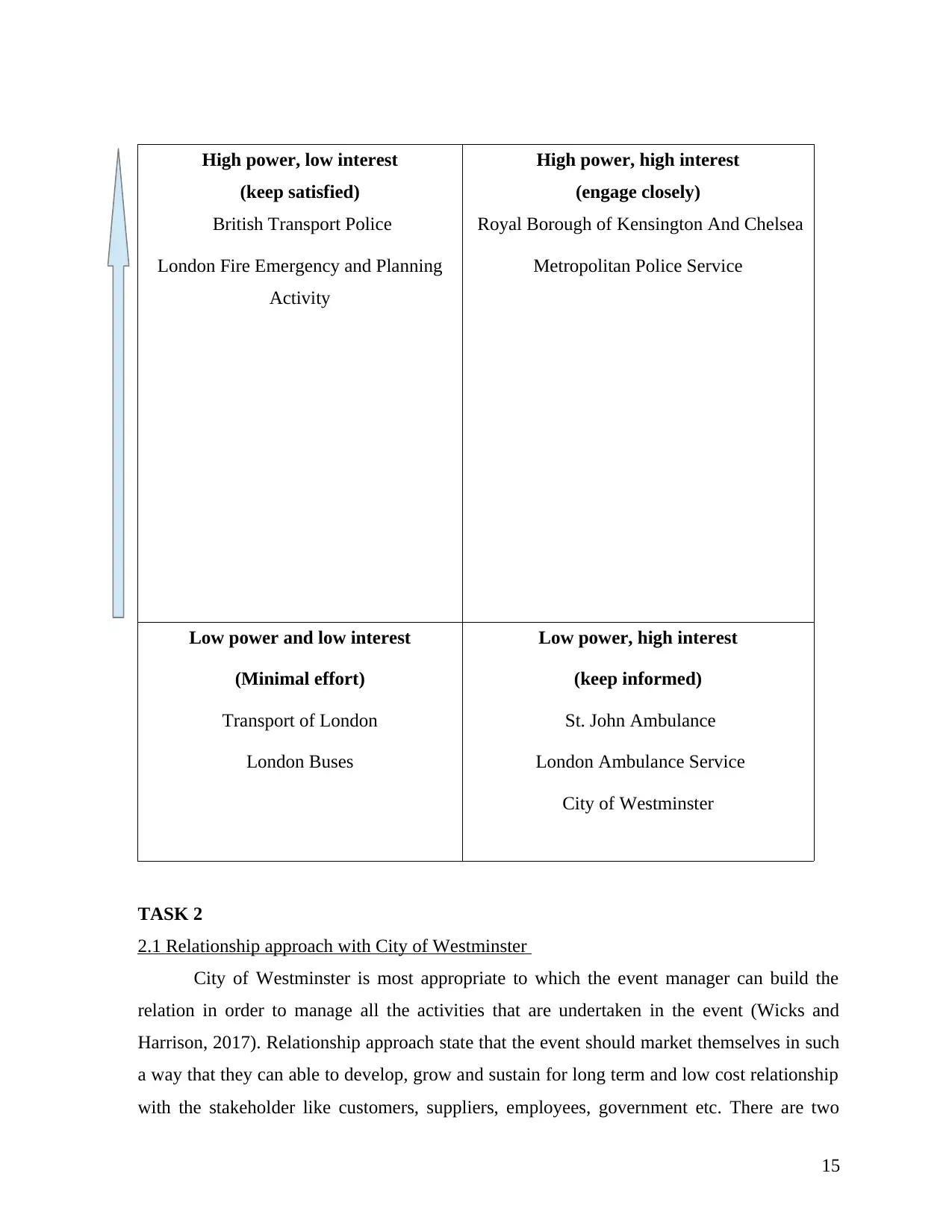
High power, low interest
(keep satisfied)
British Transport Police
London Fire Emergency and Planning
Activity
High power, high interest
(engage closely)
Royal Borough of Kensington And Chelsea
Metropolitan Police Service
Low power and low interest
(Minimal effort)
Transport of London
London Buses
Low power, high interest
(keep informed)
St. John Ambulance
London Ambulance Service
City of Westminster
TASK 2
2.1 Relationship approach with City of Westminster
City of Westminster is most appropriate to which the event manager can build the
relation in order to manage all the activities that are undertaken in the event (Wicks and
Harrison, 2017). Relationship approach state that the event should market themselves in such
a way that they can able to develop, grow and sustain for long term and low cost relationship
with the stakeholder like customers, suppliers, employees, government etc. There are two
15
(keep satisfied)
British Transport Police
London Fire Emergency and Planning
Activity
High power, high interest
(engage closely)
Royal Borough of Kensington And Chelsea
Metropolitan Police Service
Low power and low interest
(Minimal effort)
Transport of London
London Buses
Low power, high interest
(keep informed)
St. John Ambulance
London Ambulance Service
City of Westminster
TASK 2
2.1 Relationship approach with City of Westminster
City of Westminster is most appropriate to which the event manager can build the
relation in order to manage all the activities that are undertaken in the event (Wicks and
Harrison, 2017). Relationship approach state that the event should market themselves in such
a way that they can able to develop, grow and sustain for long term and low cost relationship
with the stakeholder like customers, suppliers, employees, government etc. There are two
15
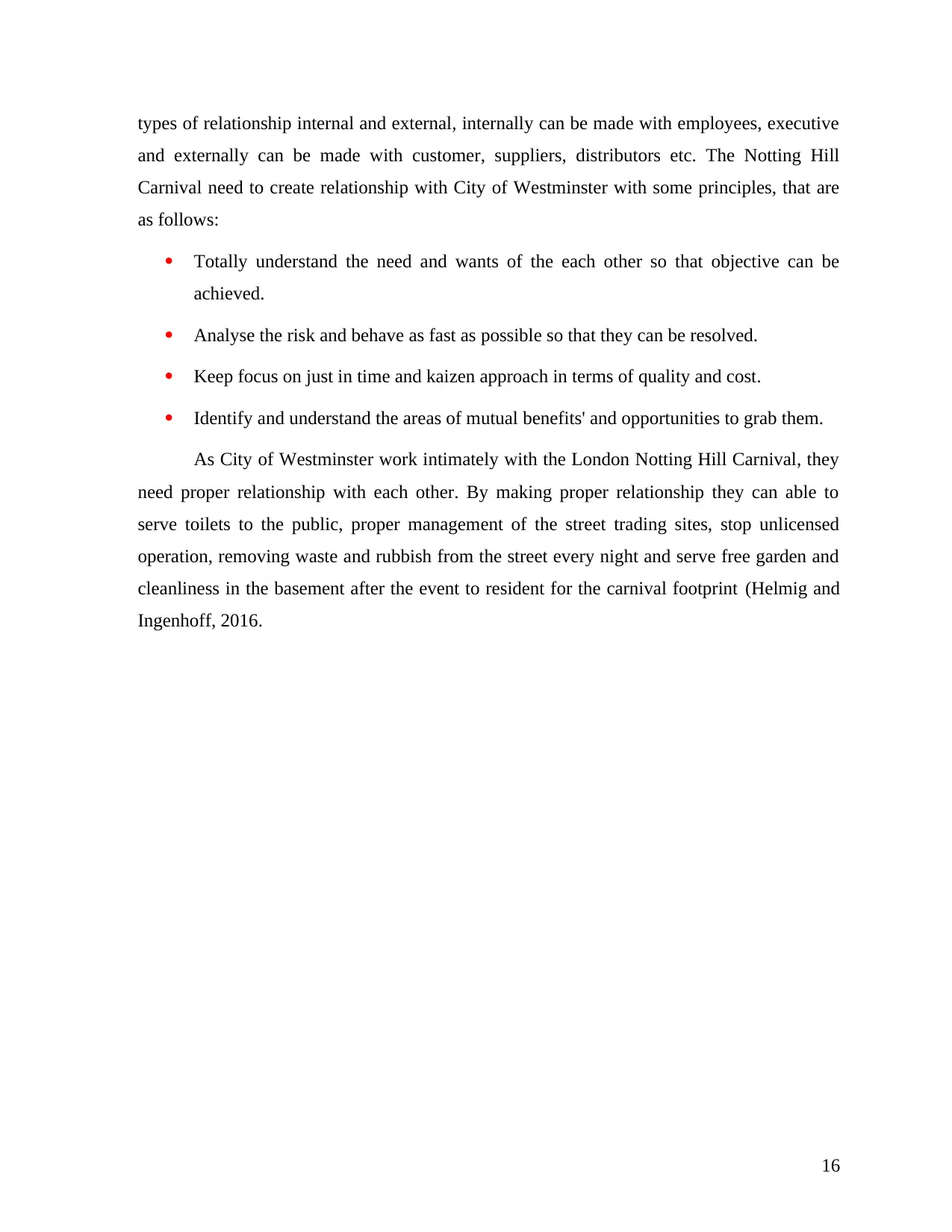
types of relationship internal and external, internally can be made with employees, executive
and externally can be made with customer, suppliers, distributors etc. The Notting Hill
Carnival need to create relationship with City of Westminster with some principles, that are
as follows:
Totally understand the need and wants of the each other so that objective can be
achieved.
Analyse the risk and behave as fast as possible so that they can be resolved.
Keep focus on just in time and kaizen approach in terms of quality and cost.
Identify and understand the areas of mutual benefits' and opportunities to grab them.
As City of Westminster work intimately with the London Notting Hill Carnival, they
need proper relationship with each other. By making proper relationship they can able to
serve toilets to the public, proper management of the street trading sites, stop unlicensed
operation, removing waste and rubbish from the street every night and serve free garden and
cleanliness in the basement after the event to resident for the carnival footprint (Helmig and
Ingenhoff, 2016.
16
and externally can be made with customer, suppliers, distributors etc. The Notting Hill
Carnival need to create relationship with City of Westminster with some principles, that are
as follows:
Totally understand the need and wants of the each other so that objective can be
achieved.
Analyse the risk and behave as fast as possible so that they can be resolved.
Keep focus on just in time and kaizen approach in terms of quality and cost.
Identify and understand the areas of mutual benefits' and opportunities to grab them.
As City of Westminster work intimately with the London Notting Hill Carnival, they
need proper relationship with each other. By making proper relationship they can able to
serve toilets to the public, proper management of the street trading sites, stop unlicensed
operation, removing waste and rubbish from the street every night and serve free garden and
cleanliness in the basement after the event to resident for the carnival footprint (Helmig and
Ingenhoff, 2016.
16

2.2 Ladder of loyalty and current relationship stage between Notting Hill Carnival and City
Of Westminster
The loyalty ladder states that there should be long term relationship with the City of
Westminster. They have an ability to turn their relationship into strong point. it is also known
as relationship marketing concept which tells that the relationship level will increase stage by
stage. It has five stages suspect, which is when someone come in between the event
promotion. Prospect is when anyone is interested in the event promotion. Shopper is the
person who will buy the product to do promotion and the sell it. Customer is the person who
will buy the product and member is who continuously buy the company product. Advocate is
the person who do mouth publicity and raving fan is the person who will sell the product on
behalf of company.
City Of Westminster and Notting Hill Carnival is at member stage where they are
member of each other and when so ever the event is organised by the Notting Hill Carnival ,
17
Of Westminster
The loyalty ladder states that there should be long term relationship with the City of
Westminster. They have an ability to turn their relationship into strong point. it is also known
as relationship marketing concept which tells that the relationship level will increase stage by
stage. It has five stages suspect, which is when someone come in between the event
promotion. Prospect is when anyone is interested in the event promotion. Shopper is the
person who will buy the product to do promotion and the sell it. Customer is the person who
will buy the product and member is who continuously buy the company product. Advocate is
the person who do mouth publicity and raving fan is the person who will sell the product on
behalf of company.
City Of Westminster and Notting Hill Carnival is at member stage where they are
member of each other and when so ever the event is organised by the Notting Hill Carnival ,
17
Paraphrase This Document
Need a fresh take? Get an instant paraphrase of this document with our AI Paraphraser

they will hire City Of Westminster to arrange all the activities they previously did (Wicks
and Harrison, 2017).
2.3 Importance of Notting Hill Carnival organisers constructing trust and loyalty, with the
City Of Westminster
Trust and loyalty is very important aspect to build a relationship with the stakeholder, without
it no agreement and contract will be made, it is important for Notting Hill Carnival to build
trust with City of Westminster and it can be done in many ways, that are as follows (Bourne,
2016).
By knowing each other: Communication of information can build trust with the
stakeholders. If the event manager will transfer the relevant information to the City of
Westminster, then they will be able to trust them and which leads to increase in
loyalty.
Stay organised: the event is organised every year, if the Notting Hill Carnival will
always hire City Of Westminster then it will build loyalty with other because they will
able to trust each other.
2.4 Modes of communications and their objective with the message and medium.
Communication is the process of transferring message from open person to other. The
person who send the message is sender and to whom the message is sent is receiver. It can be
done by verbal and no verbal communication. Verbal communication is the process by which
the message is transferred with the word of mouth as well as piece of writing. It is done in
two ways oral and written.
In oral, words are spoken by the sender and receiver where is written the message is
written on the peace of paper which is in the form of memos, report and electronic mail.
Nonverbal communication is when the message is sent wordless such as gestures, posture and
body language (Diouf and Boiral,2017). The objective of verbal communication is to provide
the proper information and medium is telephone, Skype, reports, email etc. and nonverbal
communication objective is when the information is not large and message is sent in indirect
way and medium are gesture, posture etc.
18
and Harrison, 2017).
2.3 Importance of Notting Hill Carnival organisers constructing trust and loyalty, with the
City Of Westminster
Trust and loyalty is very important aspect to build a relationship with the stakeholder, without
it no agreement and contract will be made, it is important for Notting Hill Carnival to build
trust with City of Westminster and it can be done in many ways, that are as follows (Bourne,
2016).
By knowing each other: Communication of information can build trust with the
stakeholders. If the event manager will transfer the relevant information to the City of
Westminster, then they will be able to trust them and which leads to increase in
loyalty.
Stay organised: the event is organised every year, if the Notting Hill Carnival will
always hire City Of Westminster then it will build loyalty with other because they will
able to trust each other.
2.4 Modes of communications and their objective with the message and medium.
Communication is the process of transferring message from open person to other. The
person who send the message is sender and to whom the message is sent is receiver. It can be
done by verbal and no verbal communication. Verbal communication is the process by which
the message is transferred with the word of mouth as well as piece of writing. It is done in
two ways oral and written.
In oral, words are spoken by the sender and receiver where is written the message is
written on the peace of paper which is in the form of memos, report and electronic mail.
Nonverbal communication is when the message is sent wordless such as gestures, posture and
body language (Diouf and Boiral,2017). The objective of verbal communication is to provide
the proper information and medium is telephone, Skype, reports, email etc. and nonverbal
communication objective is when the information is not large and message is sent in indirect
way and medium are gesture, posture etc.
18
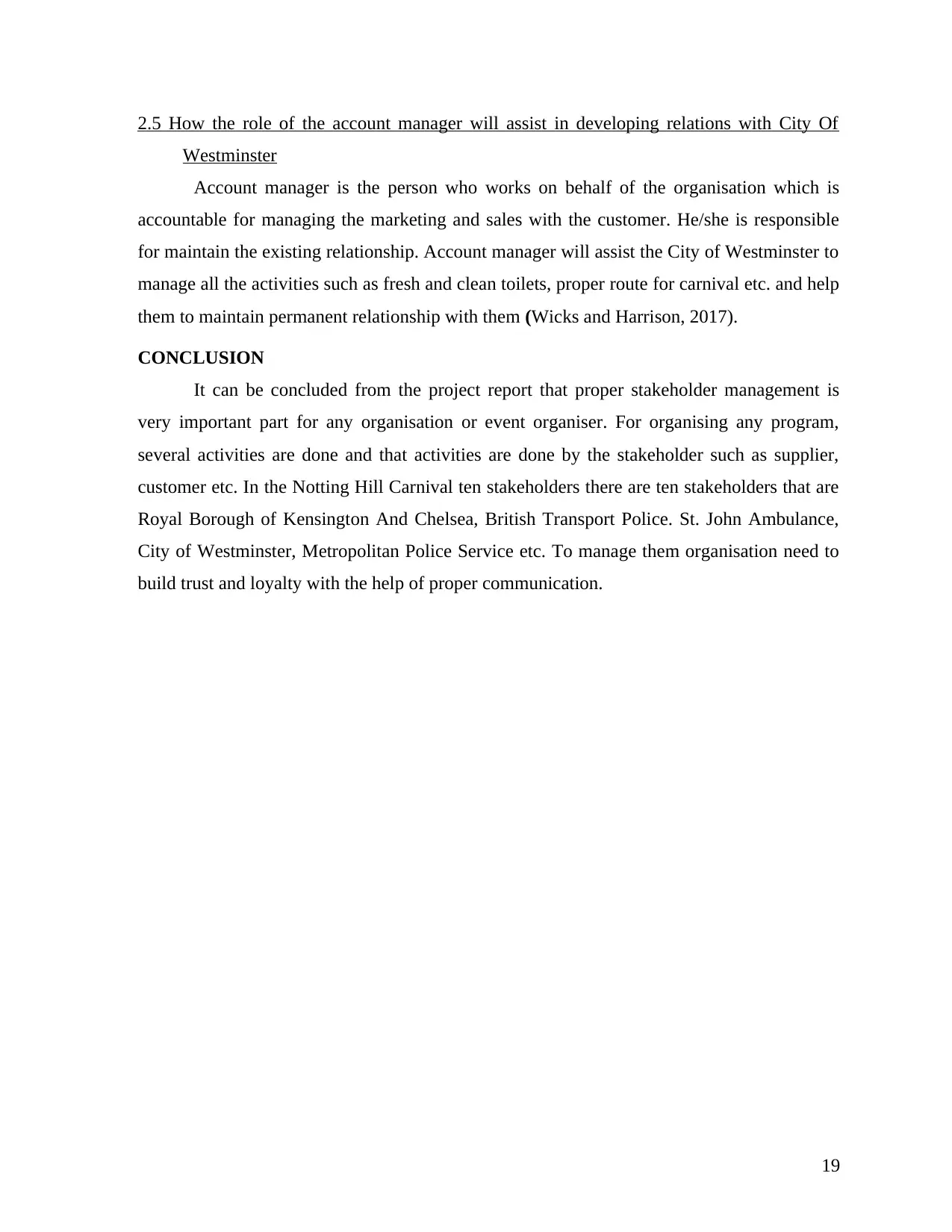
2.5 How the role of the account manager will assist in developing relations with City Of
Westminster
Account manager is the person who works on behalf of the organisation which is
accountable for managing the marketing and sales with the customer. He/she is responsible
for maintain the existing relationship. Account manager will assist the City of Westminster to
manage all the activities such as fresh and clean toilets, proper route for carnival etc. and help
them to maintain permanent relationship with them (Wicks and Harrison, 2017).
CONCLUSION
It can be concluded from the project report that proper stakeholder management is
very important part for any organisation or event organiser. For organising any program,
several activities are done and that activities are done by the stakeholder such as supplier,
customer etc. In the Notting Hill Carnival ten stakeholders there are ten stakeholders that are
Royal Borough of Kensington And Chelsea, British Transport Police. St. John Ambulance,
City of Westminster, Metropolitan Police Service etc. To manage them organisation need to
build trust and loyalty with the help of proper communication.
19
Westminster
Account manager is the person who works on behalf of the organisation which is
accountable for managing the marketing and sales with the customer. He/she is responsible
for maintain the existing relationship. Account manager will assist the City of Westminster to
manage all the activities such as fresh and clean toilets, proper route for carnival etc. and help
them to maintain permanent relationship with them (Wicks and Harrison, 2017).
CONCLUSION
It can be concluded from the project report that proper stakeholder management is
very important part for any organisation or event organiser. For organising any program,
several activities are done and that activities are done by the stakeholder such as supplier,
customer etc. In the Notting Hill Carnival ten stakeholders there are ten stakeholders that are
Royal Borough of Kensington And Chelsea, British Transport Police. St. John Ambulance,
City of Westminster, Metropolitan Police Service etc. To manage them organisation need to
build trust and loyalty with the help of proper communication.
19
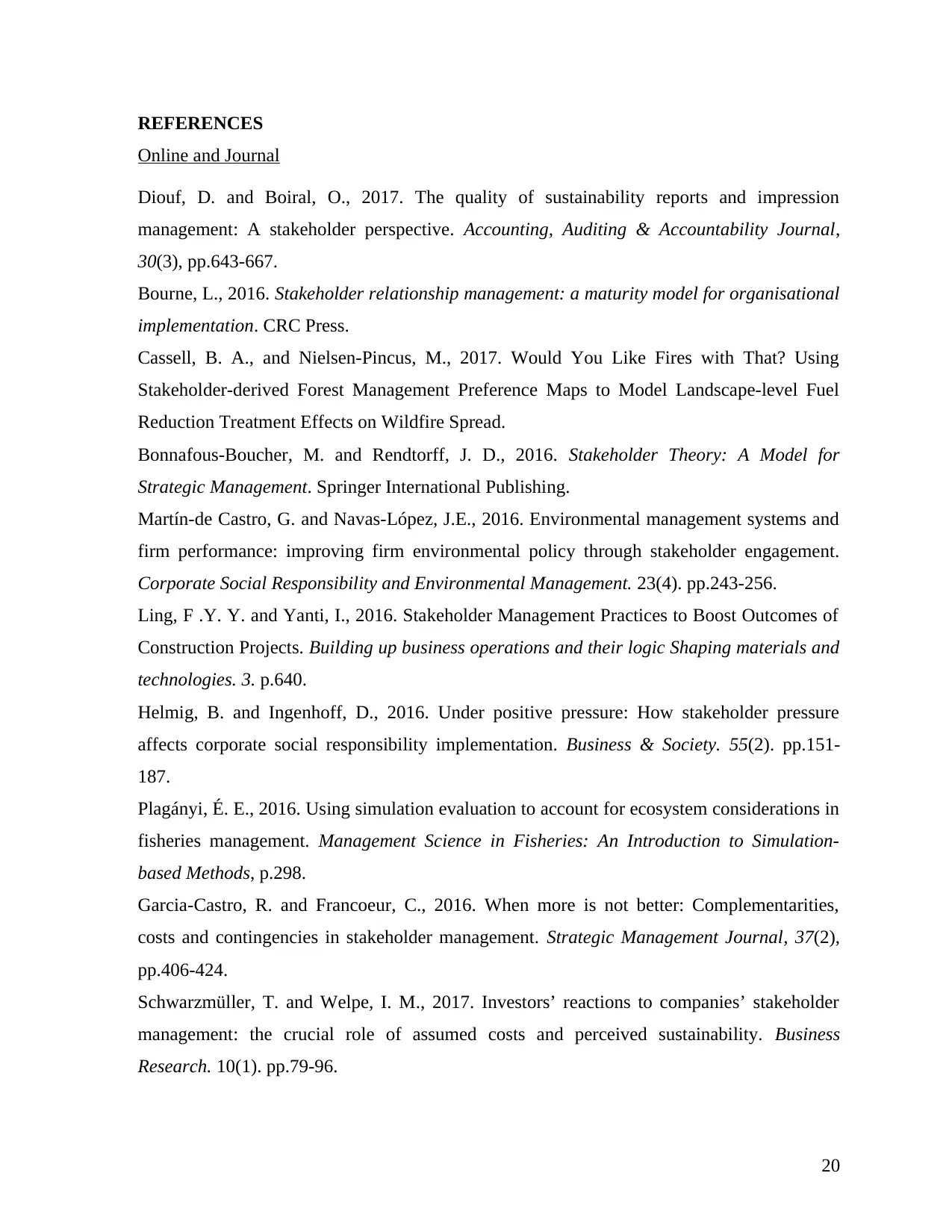
REFERENCES
Online and Journal
Diouf, D. and Boiral, O., 2017. The quality of sustainability reports and impression
management: A stakeholder perspective. Accounting, Auditing & Accountability Journal,
30(3), pp.643-667.
Bourne, L., 2016. Stakeholder relationship management: a maturity model for organisational
implementation. CRC Press.
Cassell, B. A., and Nielsen-Pincus, M., 2017. Would You Like Fires with That? Using
Stakeholder-derived Forest Management Preference Maps to Model Landscape-level Fuel
Reduction Treatment Effects on Wildfire Spread.
Bonnafous-Boucher, M. and Rendtorff, J. D., 2016. Stakeholder Theory: A Model for
Strategic Management. Springer International Publishing.
Martín‐de Castro, G. and Navas‐López, J.E., 2016. Environmental management systems and
firm performance: improving firm environmental policy through stakeholder engagement.
Corporate Social Responsibility and Environmental Management. 23(4). pp.243-256.
Ling, F .Y. Y. and Yanti, I., 2016. Stakeholder Management Practices to Boost Outcomes of
Construction Projects. Building up business operations and their logic Shaping materials and
technologies. 3. p.640.
Helmig, B. and Ingenhoff, D., 2016. Under positive pressure: How stakeholder pressure
affects corporate social responsibility implementation. Business & Society. 55(2). pp.151-
187.
Plagányi, É. E., 2016. Using simulation evaluation to account for ecosystem considerations in
fisheries management. Management Science in Fisheries: An Introduction to Simulation-
based Methods, p.298.
Garcia‐Castro, R. and Francoeur, C., 2016. When more is not better: Complementarities,
costs and contingencies in stakeholder management. Strategic Management Journal, 37(2),
pp.406-424.
Schwarzmüller, T. and Welpe, I. M., 2017. Investors’ reactions to companies’ stakeholder
management: the crucial role of assumed costs and perceived sustainability. Business
Research. 10(1). pp.79-96.
20
Online and Journal
Diouf, D. and Boiral, O., 2017. The quality of sustainability reports and impression
management: A stakeholder perspective. Accounting, Auditing & Accountability Journal,
30(3), pp.643-667.
Bourne, L., 2016. Stakeholder relationship management: a maturity model for organisational
implementation. CRC Press.
Cassell, B. A., and Nielsen-Pincus, M., 2017. Would You Like Fires with That? Using
Stakeholder-derived Forest Management Preference Maps to Model Landscape-level Fuel
Reduction Treatment Effects on Wildfire Spread.
Bonnafous-Boucher, M. and Rendtorff, J. D., 2016. Stakeholder Theory: A Model for
Strategic Management. Springer International Publishing.
Martín‐de Castro, G. and Navas‐López, J.E., 2016. Environmental management systems and
firm performance: improving firm environmental policy through stakeholder engagement.
Corporate Social Responsibility and Environmental Management. 23(4). pp.243-256.
Ling, F .Y. Y. and Yanti, I., 2016. Stakeholder Management Practices to Boost Outcomes of
Construction Projects. Building up business operations and their logic Shaping materials and
technologies. 3. p.640.
Helmig, B. and Ingenhoff, D., 2016. Under positive pressure: How stakeholder pressure
affects corporate social responsibility implementation. Business & Society. 55(2). pp.151-
187.
Plagányi, É. E., 2016. Using simulation evaluation to account for ecosystem considerations in
fisheries management. Management Science in Fisheries: An Introduction to Simulation-
based Methods, p.298.
Garcia‐Castro, R. and Francoeur, C., 2016. When more is not better: Complementarities,
costs and contingencies in stakeholder management. Strategic Management Journal, 37(2),
pp.406-424.
Schwarzmüller, T. and Welpe, I. M., 2017. Investors’ reactions to companies’ stakeholder
management: the crucial role of assumed costs and perceived sustainability. Business
Research. 10(1). pp.79-96.
20
1 out of 22
Your All-in-One AI-Powered Toolkit for Academic Success.
+13062052269
info@desklib.com
Available 24*7 on WhatsApp / Email
![[object Object]](/_next/static/media/star-bottom.7253800d.svg)
Unlock your academic potential
© 2024 | Zucol Services PVT LTD | All rights reserved.

